#also I’ve only seen a little of the 80s and 2003 but I still have good impressions of them
Explore tagged Tumblr posts
Text
I’M BORED so I’m gonna rank every Casey Jones from every animated series




3.5/5 - he’s so funny oh my god. The way he talks is absolutely hilarious like I half expect him to just yell at the top of his lungs but he has such a low quiet voice like dude just go feral I know you want to. He’s so weird too, it’s so funny to me that they just made him into some weirdo really hellbent on being a vigilante. Not my favorite but god he’s funny
2k3

4/5 - Love this guy!!! He’s really fun but also clearly heartfelt and passionate. I love that he’s kind of a himbo, but has good intentions at all times. I like that they took on a more brotherly role with his character in this version, especially since he is an adult, it feels really natural. Also his Brooklyn accent is great, he’s just great.
2k12

5/5 - MY ENTIRE SON!!!!! Okay look I love him, he’s such a damn good character. I think he perfectly balanced out the friendship with the turtles, as well as the same amateur vigilante the others had, while also being able to be the same age as the turtles and have it all come together very nicely. He has that great dorky personality and he’s plenty skilled even without the turtles help. I also think he just has that really big heart that gets overlooked a lot, but he really does care about his friends and you can tell. He’s just the perfect Casey in my eyes I will not apologize for this :)
Rise (Cassandra)

3/5 - I LOVE HERRR but I think as a Casey Jones, she’s not the best one per say. I love that she retains the crazy, overzealous energy as the 80s version, and the twist to make her a member of the Foot was really fun and interesting, I didn’t see it coming! I also like that she does have actual interpersonal conflict about her morality, and you get the feeling that she’s a good person in a weird position potentially because that’s how she was raised. But since we go the whole series not knowing she’s Casey, and a lot of the core elements of Casey Jones is lost on her because of that, I don’t think she’s the best Casey Jones. But as a character? She’s wonderful and I adore her!!
Rise (Casey Jr.)

4/5 - MY BELOVED BOY!!!!!!!! HAVE I EVER MENTIONED HOW MUCH I ADORE HIMMM!!!! So like, I think this Casey has a lot of the same shortcomings as Cassandra, in that the role being played isn’t as reminiscent of past Casey Jones versions. BUT this version is explicitly Casey Jones in the entire movie, and a lot of what he does is very similar to the versions before him (not that he needs to be but yk). He’s very heartfelt and emotion driven like the others, but he’s far from a pushover and isn’t afraid to snap if he needs to. I think it’s interesting that they flipped the older brother relationship 2k3 had with the turtles by making Casey the younger person in the situation who looks up to the turtles, which hasn’t been done in the series yet. But, like all Casey Jones before him, he fits in perfectly with the turtles, and is a really great character that I adored. I also like how they fit the hockey player vibe into his design, that was really fun :)
In short!!! I love all Casey Jones and they’re all my beloved little guys :)
#emmie speaks#I love all of them so no slander here#also I’ve only seen a little of the 80s and 2003 but I still have good impressions of them#tmnt#tmnt 1987#tmnt 2003#tmnt 2012#rottmnt#rottmnt movie#casey jones#cassandra jones
133 notes
·
View notes
Note
FRANKY!!!! I wanted to rant abt this earlier but it completely slipped my mind. Ok so. I have a new hyperfixation. And it’s been so long since I’ve been obsessed with this show. Being obsessed with it again feels so nostalgic it’s great. The show in question is Rise of the Teenage Mutant Ninja Turtles. I grew up with TMNT it is my childhood I just love it so much. And see I’m the kind of person that’s irrationally stubborn abt reboots like NO I WILL NOT WATCH IT I AM LOYAL and then is not only eventually convinced to watch it but also ends up loving it too asfdhkkhfffgf 💀. The 2003 version is the one I grew up with and is my favorite 🥰. I watched the 2012 version too when it was completed and I was older and I both enjoyed it and had a bunch of issues with it. And for the last few months rottmnt 2018 has literally been everywhere (I think cause the movie came out back in August) and I was (predictably) like no I am not watching it *sniffs in stubbornness*. But then I was won over with the theme song and the cowabunga song 😒. And so I started watching it the other day. AND LET ME TELL YOU. I am obsessed. JUST EVERYTHING ABT IT AMAZING I JUST CANNOT UGH ITS SO GOOD. I highly recommend it. And I was like well this is gonna be the obsession that gets me through the shit I’m going through rn (besides one piece ofc). See like I’ve noticed a pattern with my obsessions. There’s always a big life changing one along with a second slightly smaller one as like back up or something asdhjffhjgff lol. Sorry abt that rant. I hope your rats are doing good. Pls give them lots kisses and pets from me. And I hope you’re doing better today too! I saw the spooky movie rec list and I think Im gonna watch The Purge cause I haven’t actually seen any of them before. I’ll let you know how it goes. Anyways as always I hope you have a great or okay (because somethings okay is more than enough) day! *sends many virtual hugs*
- virtual hug anon
Haha see I grew up with the TMNT that aired from 1987 till 1996 so like even older still then what you are used to. I don't often like reboots, I never liked any of the other TMNT things and I am the same with Transformers, My Little Pony, Carebears, Rainbow Brite etc I'm old and a big gen 1 person.
Beast Wars was okay for Transformers.
Though things like X-Men Evolution hit better then the older X-men so I dunno what to tell you.
I have a few friends SUPER into the new turtles tho and I tried an ep and I'm not sold but I think cus I'm so used to the 80s stuff and I miss the vibes of being a kid and watching it if that makes sense?
My rats are mostly okay, my lil girl still sick and needs to get over her cold before she has her big op but she's getting so many kisses and cuddles as they all are.
They will get treats tonight <3 and I hope you are well to my dear <3
5 notes
·
View notes
Text
Top 10 Controversial Horror Films That Are Famous For All The Wrong Reasons *gags* *cries*
At the beating heart of horror is offence.
From that undeniable sense of something not being quite right, to the CGI-blood-spurtin’-adrenaline-fuelled scenes that leave us shaking in our boots, horror pivots on the knife edge of controversy.
It’s used to drive plots. It’s used to drive hype. And at the end of the month, it drives studio executives to the bank.
Horror films can be traumatic enough. But there are some films that bear the cross of controversy more than others. There are some films that have been branded as so damaging to their potential viewers that merely circulating copies of the film is illegal.
And yet their infamy has forged cult viewership. What was once shielded from us has now become ‘must see’.
Today we are going to be counting down horror’s most controversial films and what made them quite so topical.
*I’m going to star the ones that you can actually watch without getting traumatised. Some are controversial not because of their content but because some religious or political groups disagreed with them*
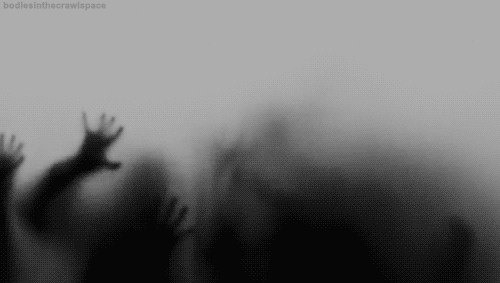
#10 - The Blair Witch Project (1999)*
Let’s ease in with a classic - a classic you can watch without sleeping with the light on.
In this found-footage flick we see a team of film students as they explore a local urban legend. But what they find leads them to unknown and ungodly territory.
The problem with this film is that it was marketed as a true story. No, not based on a true story, a true story. Yep, they claimed what we were seeing was real, found footage of some teens going mad as they forage deeper into mysterious woods.
IMBd went so far as to report that the actors were dead. Then, the movie studio super-charged their efforts to confirm to the public that not only was this film 100% real, the three main actors were still missing. The parents of the actors then started receiving sympathy cards.
There’s even a mocked up website that perpetuates these claims.
#9 - Night Of The Living Dead (1968)*
Time for another not-too-disturbing film.
This is the original zombie apocalypse film saw a group of Americans attempt to survive an incoming attack of the undead while trapped in a rural farmhouse.
But the Motion Picture Association of America wasn’t too happy about it. The film rating system was yet to be in place, allowing children to also show up for an afternoon screening and be greeted by a 97 minute montage of extreme violence.
“The kids in the audience were stunned. There was almost complete silence. The movie had stopped being delightfully scary about halfway through, and had become unexpectedly terrifying. There was a little girl across the aisle from me, maybe nine years old, who was sitting very still in her seat and crying”
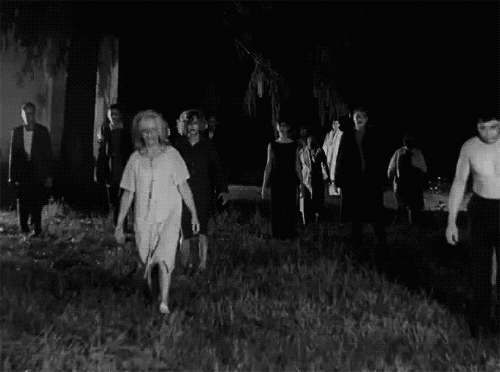
#8 - Henry: Portrait of a Serial Killer (1986)
In this psychological film, we watch a random crime spree take place at the hands of a couple serial killers. Loosely based on real murderers Henry Lee Lucas and Ottis Toole, its controversial reputation was founded on the gore ‘n’ guts screened in the movie.
Whilst it didn’t receive much attention from the public, various classification boards across the world ensured new versions edited with certain scenes - often involving sexual assault and necrophilia - removed for viewers.
In 2003, the BBFC (the UK classification board) finally allowed the uncut version to be released and Australia followed suit in 2005.
#7 - I Spit On Your Grave (1978)
It’s the original rape-revenge flick. And it managed to piss everyone off.
Originally titled Day of the Woman, it tells the story of a fiction writer who exacts revenge on a group of four men who gang rape her.
Despite its pro-women claim-to-fame, the 30 minute rape scene begs to differ. Furious debate surrounds its feminist label as a film that forces the audience to endure rape from a female perspective and long-winded violence against men (something which is often reserved for women in horror). Regardless, the graphic violence earned it a steady ban in Ireland, Norway, Iceland, and West Germany.

#6 - Silent Night, Deadly Night (1984)*
You don’t get many controversial Christmas films. They typically stick to a cookie-cutter plot ‘n’ purpose every holiday season. But there are no strong women who need to rediscover the meaning of Christmas here.
Instead, we see a child traumatised by seeing his parents murdered on Christmas Eve go on a seasonal rampage as an adult.
A week after its release in the early 80s, it was pulled from theatres due to backlash. Marketing was focused on a Santa Claus killer with adverts often airing during family-friendly TV programmes and meant numerous children developed a phobia of Father Christmas. Large crowds protested cinemas with one notable protest involving angry families singing carols at the Interboro Quad Theater in The Bronx.
It was only in 2009 - 25 years after its original release - that a DVD of the film was first made available for purchase in the UK.
#5 - Psycho (1960)*
This legendary film follows the disappearance of a young woman after her encounter with a strange man called Norman Bates, one of horror’s most iconic figures. The controversy that would engulf this fim lay not in the violent attack on an innocent woman or even the disturbing content of the film.
Oh, no. It was because of what the leading lady was wearing.
In the opening scene of the film, we see Janet Leigh wearing nothing but a bra.
*gasp*
This racy attire was emblazoned across promotional material, meeting Hitchcock’s high standards of creating controversy around the movie. There was a no late admission policy for movie theaters, and the posters told viewers “Do not reveal the surprises!” to maintain a mysterious aura around the plot twist.

#4 - The Human Centipede (2009) (all of ‘em)
I’ve watched a lot of horror films, in case you couldn’t tell.
I’m used to watching a scary movie, shaking off the anxiety, and moving on with my life. But there are some that stayed with me. I only watched the trailer for the first movie, and it legitimately traumatised me. It gave me quite a severe, sudden bout of a depression for a solid month when I was 13.
Throughout horror’s goriest franchise, we see an evil doctor and amateur mad scientist attempt to sow several people together into a centipede-like chain from mouth to anus.
*retches*
At the heart of promoting the franchise was controversy. Tom Six, the director, forced a narrative that claimed from the first film that this was "100% medically accurate". He even alleged a Dutch doctor helped inspire the film, confirming that with an IV drip, this was entirely possible.
Although it didn’t receive furore that amounted to serious censorship or long-term banning, it was infamous for having its viewers vomiting in the cinema aisles.
The second film, however, was subject to much more severe controversy and could not legally be supplied in the UK until 2011 due to its heavy focus on sexual abuse, more graphic violence than the original film, and it’s pretty vile depiction of a murderer that was intellectually disabled.
Audiences were used to the graphic nature of the franchise by the third and final release. As the least-controversial and least-enjoyable film according to critics, it barely made a dent in the horror community.
Good riddance, I guess?
#3 - Faces Of Death (1978)
I’m not sure I’d recommend this one per se - but I will give it credit for being an interesting project.
This documentary-style film is a montage of footage of people dying in different ways. As a result of its very graphic and very real content, it was banned and censored in many countries. Only in 2003 was it released on DVD in the UK after a scene was cut featuring dogs fighting and a monkey being beaten to death.
Germany, Australia, and New Zealand followed suit, reversing their bans and releasing edited versions.
However, 7 years after its release, the media revamped its interest in the film after a maths teacher showed it to his class at a Californian high school. Two of his students claimed they were so traumatised they received a costly settlement to reimburse their emotional distress. Things took a darker turn a year later, when a 14 year old bludgeoned a classmate to death with a baseball bat; he claimed he wanted to see what it would be like to actually kill someone after watching Faces of Death.
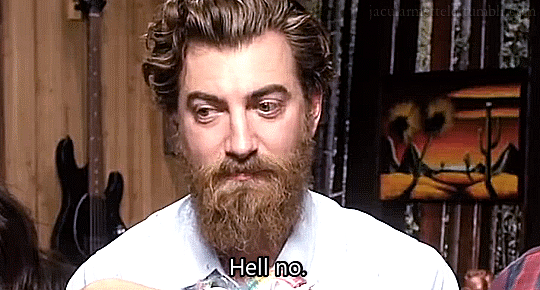
#2 - Cannibal Holocaust (1980)
This Italian film’s title alone hints towards two frightening things: flesh-eating humans and genocide. In this found-footage movie we see an anthropologist lead a rescue team into the Amazon rainforest to find a group of filmmakers that went missing.
The rampant graphic content including sexual assault and animal cruelty showcased in the film (7 animals were killed during filming in some pretty horrific ways) led to it being banned in 50 countries.
Some also alleged that a handful of deaths seen in the film were real, as were the missing film crew. In fact, the actors portraying the documentarians signed contracts that stopped them appearing in motion pictures for an entire year to maintain the illusion of reality.
And only 10 days after its premiere, the director was charged with obscenity and the film confiscated. All copies were to be turned over to the authorities. There are currently a range of versions that have been edited to varying degrees and are allowed for circulation.
#1 - A Serbian Film (2010)
No.
Nope.
Don’t do it. Don’t watch this film.
A Serbian Film follows a retired porn star who agrees to feature in an “art film” for some cash. Little does he know this film will include rape, incest, pedophilia, necrophilia…
Just don’t watch it.
It is still banned in South Korea, New Zealand, Australia. It is supposedly a parody of politically correct films made in Serbia that are funded by foreign groups and allegedly speaks openly about post-war society and the struggle for survival.
*shakes head*
Off to have a 3 hour shower, brb.
If you, uhhh, liked this post please like and reblog.
And if you want to hear more about horror and the supernatural every week hit follow!
#horror#Horror Movies#horror films#best horror movies#scary movies#banned films#video nasty#a serbian film#human centipede#the blair witch project#cannibal holocaust#faces of death#banned movies#censorship#night of the living dea#controversy#controversial films
98 notes
·
View notes
Text
Author interview, tagged by @dreadfutures some time ago
1. Name: Victoriousscarf and that’s all you’re getting lol
2. Fandoms: constantly changing but some highlights include Dragon Age, Marvel, DC, Tolkien, Star Wars, and Harry Potter.
3. Where you post: Yeah it’s pretty much AO3, though I’ll write prompts here before moving them to AO3
4. Most popular oneshot: According to ao3 hits which is only one metric but I don’t want to try and calculate them all it’s Looks Can be Deceiving, Even if You're on the Right Track
5. Most popular multichapter: Again going by hits for my sanity it’s the forest is dark and deep and i've seen you here before but I think it’s actually the most popular by most metrics based on the last time I was checking them. Which could make me cry y’all, you finally knocked the terrible Marvel stuff I wrote in a haze in 2012 off for top hits.
6. Actual worst part of writing: Writing the scenes I don’t wanna write
7. Favorite story you wrote: Probably at this moment still the forest is dark and deep and i've seen you here before because it’s what I’ve been working on consistently for a very long time now and I wouldn’t still be here if I wasn’t deeply, wildly invested in it. Find the Sun in the Corners of Shadows gets special mention though, I still love that monster I wrote in 6 months flat.
8. Story you were nervous to post: Usually I’m not anymore. I’ve written some deeply, deeply shady things so I always expect the antis to realize I don’t just ship the batboys, but straight up incest. Among so many other “problematic” things, but I’m also not going to ... stop writing those things. So usually I just throw stuff up while muttering “yolo.”
9. How you choose your titles: Pffft who knows. It’s based on the alignment of stars or something. Or it’s just me getting my poetry fix.
10. Complete works: 200 on ao3
11. Incomplete works: 46 on ao3 are in “non complete status.” A while ago I wrote out all my incomplete fics in a journal so I could start working on knocking out some of those “lingering in limbo for years” fics, starting with the ones with the least work to do. I got some big ones wrangled over the finish line in 2019 but then... 2020 happened.
12. Do you outline? Lol! I mean. When it’s in progress I’ll write sloppy little outlines for like the next few chapters/things I do need to do before moving onto the next big thing but they’re vague and usually very focused on a small slice of the story.
13. Coming soon ideas, maybe? idk, I always have about 80 different story ideas in the pipeline that may or may not go anywhere. Like right now I’m running on a lot of Dragon Age daydreams. One of which is that Inquisition in Space thing, and that Inquisition in the 1930s Dustbowl thing, and maybe a cold war chess au because I watched Queen’s Gambit too many times.
14. Ask me anything: The question already attached to this post already was: How did you start writing?
I used to narrate stories about Bug Bunny and Tweety Bird getting married to my mom... she would write them down and then I would illustrate them. Hilariously I think I thought Tweety Bird was a girl? Tweety Bird was not a girl, I was writing slash when I was 5 years old. I have a bunch of hand written stories along that vein, let alone the times any teacher in school was like “please do this creative writing prompt for like half a page” and I turned in three pages worth of alien backstory for a class project. Along with cut out paper dolls of the aliens in their spaceship to better illustrate multiple scenes from the story. (I still have these, I believe that was 4th grade so the 9/10 range).
For fanfiction it was back in 2003 when I started posting Inuyasha fic on fanfiction.net.
15. Best writing traits: I have been told reading my writing is like being punched when you are down when I want it to be and honestly I’m very proud of that.
16. Upcoming Story You Are Most Excited to Write: ... idk? I’m always excited about what I’m writing or I wouldn’t write it, but I couldn’t tell you which monster was about to be let out of the cage until it’s already out.
there's tumbleweed in my heart where love was supposed to be maybe?
17. Spicy Tangential Opinion: lawns are outdated status symbols that should be banished back to 18th century France. It’s all about the pollinating flowers and local vegetation baby.
5 notes
·
View notes
Text
One-sentence reviews of all the Hoffmanns I’ve seen
bc I have an unhealthy obsession with this opera and had to get it out there.
(Full disclosure: I’m a little embarrassed to reveal just how many of these I have seen. To be fair it just started with me surfing productions to see if anyone actually has the Muse come out of a barrel in the Prologue, but this opera has a way of sucking me in even if the production’s bad. And some I didn’t watch the entire production, for reasons elaborated upon below. So here I am, 25 productions all told. Probably more coming. But I thought writing this might help me get over it.)
(Incidentally, only 1/25 have the Muse coming out of a barrel in the Prologue.)
The list will be organized by date because why not.
Met 1973: It is almost impossible to see/hear this one which is tragic because it’s Sutherland, also they take out the entire Giulietta act and put the Septet in the Epilogue and suddenly it’s a quartet because apparently the director decided to replicate the word premiere without any regard to the fact that that edit is no longer relevant, even back then. 2/5.
Royal Opera House 1981: Charming and classic, alas it’s the Choudens edit, but aside from that it’s lovely and Powell is adorable as Niklausse/the Muse. 4/5
Brussels 1985: I didn’t think productions from the 80’s were allowed to be so gay *dies from the gay* 4/5
Met 1988: Featuring Adorable Baby Shicoff also why is Susan Quittmeyer’s Niklausse so pretty and can I have that outfit. 4/5.
La Scala 1995: THE GAYEST THING THAT EVER BLESSED THE OPERATIC STAGE rip me x1000000000 AHHHHHHHHHHHHH 5/5.
Paris 2002: Someone got a little (a lot) too into the Don Giovanni references but aside from that it’s pretty decent and gay and also Mentzer so yeah. 4/5.
Salzburg 2003: Apparently somebody woke up one day and asked “How can we take one of the gayest operas in history and make it as straight as we possibly can”? and this monstrosity was born—I can’t believe Salzburg would give us such a gay Don Carlo and yet burden the world with this atrociously straight Hoffmann (also APOLOGIZE RIGHT NOW to poor Shicoff for the BS you make him do here he’s my favorite Hoffmann and deserves so much better) okay I’m done now. -10/5
Macerata 2005: This production is infuriating because Maurus’s Niklausse is much too gay to be stuck with the Choudens edit (though he does get the Violin Aria, the first half of it anyway)—also someone please tell me why we’re still seeing Choudens productions in the 21st century. 3/5.
Genève 2008: Literally nothing about this is good except for Doufexis being the cutest Niklausse imaginable; a shame because it’s my favorite edit I've seen so far. 1/5
Met 2009 (Sher): Phenomenal cast; production masterfully juxtaposes the dark and comic elements of this opera while also being EXTREMELY gay. 5/5
Gran Teatre del Liceu, 2013: Much of the cast (Losier, Spyres, Naouri, Dessay, Kim) is fantastic, the rest of the show is not, but I live for Losier’s facial expressions. 3/5.
Met 2015 (Sher): Everything about the 2009 one applies here (different cast but no less phenomenal, arguably even more so in some cases) and, if you can imagine, almost even more gay. 5/5.
Munich 2011: Delightful (and delightfully gay), weird and kinda clunky edit, but the cast and production are marvelous. 5/5.
Madrid 2014: I stopped watching this one after like 15 minutes because it’s a homophobic, ableist mess that’s not worth anyone’s time (like I literally want a refund of the 15 minutes of my life I lost attempting to watch this thing). -1/5.
Bregenzer Festspiele 2015: Whoever did this one must have taken the score, tossed it into the air, picked up pages at random while leaving some on the floor, stacked them in the order they were picked up, and then played the opera in that order, because everything about this edit is WTF—NOTHING makes sense, and the production concept is equally WTF and I just have to wonder if the entire company was on shrooms or something when they were making this because I felt like I was hallucinating the entire time. 0/5.
Paris 2016: Not as cute as the 2002 one but similarly gay and the Don Giovanni thing is more obvious which is just…why. 3/5.
Royal Opera House 2016: Same production/staging as the 1981 one, but more gay because we get the Violin Aria this time. 4/5
Dutch National Opera 2018: Someone decided to take advantage of the fact that there is no definitive Hoffmann edit and change up the libretto as they pleased to match the weird production instead of the other way around, which included REMOVING THE LINE ABOUT THE MUSE BEING NIKLAUSSE so yeah, we get a girl for the entire opera because whoever did this must have been some kind of homophobe, and not even the mostly-great cast can make up for it. -1/5
Monte-Carlo 2018: Could have been great—the production concept is interesting and most of the cast is glorious, though truthfully Flórez is too pure to play a dingus like Hoffmann, also someone please lock this Niklausse in a closet obviously the director had no idea what this opera is actually about. 2/5.
Klosterneuburg 2019: Literally the only thing that comes to mind when I think of this one is “WTF.” 0/5.
Wiener 2019: Strange but mostly decent, though not nearly gay enough, also whose kid is that who keeps popping up out of nowhere. 2/5.
Brussels 2019: 1) Why would La Monnaie make such a straight Hoffmann thirty-four years after producing one of the gayest in existence; 2) it is extremely strange to see Losier in a production like this after seeing her delightfully gay and adorable Niklausse in the Liceu production from six years prior; and 3) does anyone know what this production is supposed to be because honestly I have no idea. 0/5.
Moscow 2019: WHY ARE WE STILL DOING CHOUDENS 19 YEARS INTO THE 21st CENTURY either because of that or just in general, a very mediocre production. 1/5.
Seoul 2019: This one could give Vienna a run for its money in terms of lighting; it’s an interesting production concept with elaborate sets and pretty good acting, but it’s hard to follow much of that because it’s very, very dimly lit. 2/5.
Buenos Aires 2019: It only took 138 years for someone to finally let these two kiss (though I desperately wish there had been more buildup to that moment, because the rest of the production is not very gay and pretty mediocre). 1/5.
Further thoughts (under the line)
Met 1973: Pretty much all has been said; it’s honestly so hard to see and hear I could barely get through it. Though it’s super abbreviated, the Muse gets a spoken monologue at the start of the opera that’s basically what she would have been singing. I don’t really get it.
Royal Opera House 1981: This was the first Hoffmann I ever saw, so it’ll forever hold a special place in my heart. The set and costumes are enchanting and luscious. It’s the abbreviated version so we miss a lot, and the villains are all played by different baritones, which is just odd. But Powell is a super adorable Niklausse, very protective of Hoffmann, sneaking around in the background at times to spy on him because he’s so worried he’s going to get hurt. Also, as old and prim as this one is, it still got me shipping these two, even before I was into the gay opera fandom. As much as the Choudens edit annoys me, I’ll always love this one.
Edit to add: I get so obsessed with Powell that I keep forgetting D*mingo is in this one, so if you want to avoid him, this probably isn’t the one for you.
Brussels 1985: I love this one. The sound and image quality aren’t great, but it’s not so bad it can’t be watched. It is VERY gay—Niklausse is painfully obviously in love with Hoffmann and tries to be very affectionate; he’s EXTREMELY jealous of all the girlfriends, and even freaks out when it looks like Lindorf might be flirting with Hoffmann (an interesting concept I’ve seen here and in the Genève 2008 one). But Hoffmann is pretty mean to Niklausse and I feel so bad for him. There are some interesting bits thrown in, too—during Antonia’s aria, we see Niklausse in the background, walking slowly across the stage with a bird perched on his hand (while Antonia is singing about the “turtledove”). It’s mysterious and intriguing and emphasizes the omnipresence of the Muse. The Violin Aria, by the way, absolutely kills me. There’s so much love and yearning from Niklausse, and Hoffmann just walks away from it (literally). Another bit—when Niklausse makes the connection between all the heroines, he runs over to Hoffmann with a drink and gives it to him when he says “Buvons à cette honnête dame” (“A toast to the honest woman”), almost like he’s trying to apologize. Then, when Hoffmann grabs the glass from him and throws it on the floor, Niklausse doesn’t even blink—just grabs another glass to give to him. Why does that kill me so much? He’s so sweet to Hoffmann during the finale, too, even after almost three hours of being shoved around. He deserves so much better.
Met 1988: Another Choudens—and not only are we deprived of the Muse’s ending monologue, all we get of the Muse is a projection of a disembodied head and a voice emanating from a barrel giving the spoken speech. Creepy? Just a bit. Are we supposed to know that it's Niklausse? No idea. Surprisingly, though, we get the Violin Aria for this one. Shicoff and Quittmeyer are just adorable together, and decently gay to boot—again surprising given it’s older. This Niklausse is VERY sassy which counterpoints Shicoff’s ridiculously adorable, super sweet Hoffmann. Also, Gwendolyn Bradley is a phenomenal Olympia, and Tatiana Troyanos slays as Giulietta. Some very impressive special effects for Dr. Miracle in the Antonia act, though I do feel bad for whoever had to clean up all that glitter.
La Scala 1995: As stated before, the gayest production of this opera I’ve yet to see. The only ones that get close are the Met 2009/2015 ones and the Brussels 1984 one. In this one there’s absolutely no space left for anyone to deny the relationship between Hoffmann and Niklausse. Even Hoffmann doesn’t deny it. He’s totally invested in it, even going out of his way in the Giulietta act to make Niklausse jealous when usually it’s the other way around. Holy moly! They’re very physically affectionate and even hold hands at one point. Just casually grab each other’s hands and walk offstage like it’s the most natural thing in the world. Did anyone think that a production from the 90s would be allowed to be so phenomenally gay? I didn’t. Honestly ask me anything about the production overall—sets, costumes, whatever—and I probably couldn’t tell you, because every time I watch this one I’m so distracted by the nonstop gayness I can’t focus on anything else. (Though I will say that Dessay is so far my favorite Olympia.) Plus it’s my favorite Hoffmann (Shicoff) paired with one of my top 5 favorite Niklausses (Mentzer) so for me it’s just an awesomeness overload. (Side note: no one seems to be able to agree if this one’s from 1995, ’96, or ’97. I go with 1995 because it’s my birth year so it must be a sign that I was born the same year as a ridiculously gay production.)
Incidentally, this is the only one I’ve seen that does, in fact, have the Muse come out of a barrel in the Prologue.
Paris 2002: Shicoff and Mentzer team up again! Unfortunately, this production is less gay and the concept is kind of odd. Apparently Lindorf is some kind of theater director who’s producing Don Giovanni. Elements from that opera are scattered throughout. Some parts of the set and background action emphasize this motif as well. The entire Septet is Lindorf putting everyone in poses because apparently they have all become mannequins. Also whoever was in charge of filming this one was obsessed with close-ups, and it gets a little annoying after a while, because I’d like to see more of the characters actually interacting. The cast is really good though, especially Shicoff and Mentzer. (You knew I was going to say that, didn’t you?) Again, their dynamic here is nowhere near as gay as the La Scala one, but it’s still pretty gay compared to many others. The production itself isn’t specifically supportive of that, but after their unbelievably gay performance seven years earlier, it’s pretty much a given that these two are going to have excellent chemistry. This Niklausse is pretty chill about it though; he’s obviously not worried about whether he’s going to get Hoffmann at the end. (He already did. Seven years ago. Irrevocably.) It’s almost like he’s just here for the ride, amused at Hoffmann’s folly and making sure he takes care of himself. Mentzer’s “Voyez-la sous son éventail” is my favorite ever—SO sassy, so unflappable, and just amazing. She’s absolutely gorgeous as the Muse, too, and we get some genuine affection between the Muse and Hoffmann at the end. While not my favorite production by any means, Mentzer’s Niklausse is one of my favorites, hands down.
Salzburg 2003: Whoever did this should apologize to the universe. The Dutch National Opera one was bad enough, but at least the production concept was interesting and the cast (save not-Niklausse) was good enough for me to want to watch a few of their numbers. This one I could barely even skim through. It’s royally messed up. The entire Muse/Niklausse/Hoffmann dynamic is reduced to a purely physical relationship with no emotional or artistic connection. Plus Niklausse’s costume is just…why. I will never be able to un-see a barefoot Angelika Kirchschlager, dressed in a sleeveless nightgown covered by an oversized great coat, sporting ridiculous bedhead and manically air-guitaring to “Voyez-la sous son éventail.” And if all that wasn’t bad enough, the things they make Hoffmann do are unacceptable, especially upsetting for me because it’s Shicoff. I’ve seen Shicoff in four Hoffmanns now, and he’s steadily become my favorite. In the Met 1988 and La Scala 1995 ones, he’s a total sweetie and I could actually imagine something good coming of his relationship with Niklausse. (In the Paris one he’s a bit less so, but still not nearly as bad as this one.) I don’t even want to go into the stuff that they do with Hoffmann here because I just don’t like thinking about it, but it’s all pretty much out of character for any incarnation of this guy. Whoever directed this thing obviously had no idea what this opera is.
Macerata 2005: Okay, this one floored me—it’s the gayest Choudens edit I’ve ever seen, and again I wasn’t expecting one from 15 years ago to be gayer than ones from last year. Maurus’s Niklausse is adorable and very gay for his poet (who’s not very receptive). Though it’s Choudens for the most part, it does have the Violin Aria, as well as the extended epilogue; which is great, but without the Muse monologue in the prologue, it doesn’t really make sense, because there’s nothing explicitly stating that Niklausse is the Muse. So if this were someone’s first production, I guess they’d figure Niklausse is Hoffmann’s little gay classmate who waxes philosophical at random moments. Aside from that confusion, I love this one for giving us a supremely adorable and gay Niklausse.
Met 2009/2015: I love both of these productions and could watch them forever. (If you’ve known me for a bit, you’ve probably seen me talk about them…a lot.) Both have amazing casts and feature Sher’s imaginative, glorious sets and staging that do an awesome job balancing the comic and dark elements in this opera. As well as the gay. So. Much. Gay. While they share many similarities, there are also things about them that I like about them separately. That’s probably an entire post of its own, though, so I’ll cut this one short. Overall, it’s my favorite production and we’re blessed to have two great performances of it.
Genève 2008: Stand by my previous statement: The only thing I like about this production is Doufexis. Doufexis is, in truth, too adorable to be Niklausse, but I’m glad we get it anyway. She’s delightfully genderfluid, very sweet and expressive, and especially great at capturing the comic aspects of the role. This production is my favorite edit--almost the complete Oeser edit that includes all the Muse’s monologues, extended Niklausse sequences, and a bunch of stuff in the Giulietta act that’s almost always taken out. The production itself is what’s lacking; the set’s okay and versatile but the blocking is odd and there’s a distracting amount of background action in some places (and an unnecessary amount of nudity throughout). Plus Hoffmann is a totally d-bag and poor Niklausse has to deal with him for over three hours. I just want Niklausse to run away—maybe go lock the Monte-Carlo Niklausse in a closet and romp around with Flórez instead. The Violin Aria here destroys me. Niklausse wanders off while singing it and Hoffmann goes over to hold him, and right at the end Niklausse turns to face him and gets really close, and then Hoffmann lets him go and walks away. Like seriously dude?? It’s bad enough when a Hoffmann just stands there or walks away, but to reciprocate like that and then leave? He’s totally leading him on and I can’t STAND it. What an asshole. And absolutely no redemption. He stays like that till the end. Why, oh why does the Muse stick around for this jerk.
[Edit: after further analysis I realize this isn't a "full" Kaye edit but one that draws heavily from Oeser as well. Still my favorite edit though.]
Munich 2011: I love this one. The edit is clunky, with pieces missing in almost every scene and some stuff added in I don’t see anywhere else. The production, though, is hands-down one of my favorites, second only to Sher’s. The sets and costumes are whimsical without being distracting, and do a great job balancing the light and dark facets of the opera. There’s no costume change for the Muse, but it’s handled better than the Monte-Carlo one and just comes across as super gay. Brower is adorable and sassy and a perfect match for Villazón’s moody, dreamy Hoffmann. Plus, we get Diana Damrau as all four heroines, and she SLAYS. I can’t get over how amazing she is. Relyea is also great as the villains (his Dr. Miracle is one of the creepiest I’ve seen) and the supporting cast does very well, though we do get the three annoying students from the prologue following us around which gets a little distracting at points. Overall though a really fun, excellent production.
Gran Teatre del Liceu 2013: There’s a lot about this one I like, and a lot that I don’t like. For one thing, Losier is one of my favorite Niklausses ever. Her phenomenally expressive face and body language, her ethereal voice, and her chemistry with the entire cast is glorious. We get some other great names—Laurent Naouri is the villains and he’s great, Kathleen Kim is Olympia again (though I’m not thrilled with how they handle her), and Natalie Dessay is Antonia, and of course she’s amazing. We get Michael Spyres as a Hoffmann who has lovely chemistry with his ladies, but is consistently annoyed with Niklausse and pretty forceful about showing that. There are some really startling things about this one—impossibly fast costume changes for the Muse/Niklausse, and at one point Dr. Miracle ducks offstage left and reappears onstage right like three seconds later—while singing. How??? The set is so dark and dreary it almost comes across as a black-and-white movie, which fits because this production focuses on the darker elements of the opera. It’s the full Kaye edit, but the dialogue version, which is interesting, and a TREAT when it comes to Losier’s acting. Losier’s Niklausse is super gay and extremely jealous of the all the ladies. She punctuates her performances with a plethora of giggles, gasps, and squeaks that fit her emotive, energetic portrayal. I could talk about her Niklausse for hours. I did one day. May or may not become its own post later.
Madrid 2014: This is the only one besides the Salzburg 2003 one that I couldn’t even skim. I don’t even know what it’s supposed to be, but it’s pretty obvious that parts of it are supposed to be in a psychiatric hospital, and Hoffmann is a patient there, and it’s just blatant ableism. I’m sure the director thought they were being so clever making a statement about Hoffmann’s mental state, without taking into account that this is offensive and hurtful. Don’t even ask me what’s the deal with Niklausse. I couldn’t begin to tell you.
Bregenzer Festspiele 2015: This one is WTF all over. As mentioned earlier, the edit is atrocious and the production is beyond whack. Not much else to say aside from that. Also TW for this one—there’s a point where it seems like one of the people onstage is getting sexually assaulted and it’s awful. Whoever did this one needs to take a long walk in the fresh air and think seriously about what their priorities are in life.
Royal Opera House 2016: Like for all the same reasons as the 1981 production. It’s also almost the entire cast from the Met 2015 one—Lindsey, Grigolo, Hampson, and Rice—so it’s an interesting juxtaposition, seeing them here compared to the much more extensive (and gay) Sher production. They do fabulously, though. Still no opening monologue for the Muse, but they do have Lindsey onstage dressed as the Muse during the opening chorus. Not entirely sure what the point is of that. If they’re going to cut out the monologue, the only way to really make up for that is to have a dramatic reveal at the end, which doesn’t happen here because we see the Muse ahead of time. I think they were trying to go for some middle ground, but it doesn’t really work imo. Aside from that though it’s a solid performance, and Niklausse gets the Violin Aria, and it’s Kate Lindsey so you know it’s gonna be good.
Paris 2016: Exact same production and staging as the 2002 one. Stéphanie d'Oustrac’s Niklausse is even sassier (to the point of almost being snide) and the whole Don Giovanni thing is even more obvious here. I still wonder why. It really doesn’t do anything for the opera. Luckily it’s not very distracting, except during the Septet. I wish these casts had been given better blocking for that. My favorite part of the whole thing is probably in the Olympia act when the guests are leaving and Hoffmann and Olympia are alone. Niklausse doesn’t leave—he stays behind because he wants to watch, but Splanzani and Cochenille each grab one of his arms and lift him and carry him away. It’s hilarious and adorable because he’s just so small they can do that. This Niklausse is quite gay but Vargas’s Hoffmann is not very receptive, which is beyond irritating for him (and me).
Monte-Carlo 2018: This one irks me to no end. It has so much potential. While I stand by Flórez being too pure to play Hoffmann, he could have done much better if things had been different. Overall, the production is good. I enjoedy the set and costumes—it’s timeless, colorful but not distracting, and a bit mystical. Nicolas Courjal makes for a pretty good set of villains (though his maniacal laugh has much to be desired) and Olga Peretyatko SLAYS as all four heroines, and her chemistry with Flórez as each of them is great. (Though there are some weird things, like Frantz tying Crespel to a chair during “Pour conjurer le danger” and putting a salt circle around him. Just…why.) The issue is with Niklausse, which throws off the entire production. If only he wasn’t such an overt tool. He pays Lindorf to mess with Hoffmann and is making fun of him and being mean to him the entire time. It’s like the roles have been reversed and the one who’s usually the asshole is the victim. Plus, there’s no costume change, so the Muse/Niklausse delineation is hazy. Munich did the same thing, but did it well, because of the way it fit into the production overall. In this one, not only do we have asshole Niklausse never changing to and from the Muse, we get a SEPARATE PERSON who comes out during the final number dressed as a Muse who goes over and gives Hoffmann a hug, after mean Niklausse has sung the Muse monologue. Like…what? Why? It makes no sense. I can only imagine that this Niklausse locked the real Muse in a closet so he could go be mean. Nothing gay about this one, it’s just messed up. For once I’m glad we don’t get the Violin Arai: it would have been totally meaningless. Again, sad because the rest of the production is pretty good.
Dutch National Opera 2018: This one’s extremely disappointing. As if Hoffmann edits weren’t already messed up, this one chops out whatever lines it pleases to make it match the production concept, instead of building the concept around the content of the opera. Imo that’s just lazy directing. Plus the girl not-Niklausse just ruins everything. It screams queer erasure. About half the text in the epilogue is changed into something I’m pretty sure has never been connected in any way to this opera—nothing about art; it’s all about Hoffmann moving on from past loves into this new one with not-Niklausse. Why???? Given Hoffmann is portrayed as an artist here, you’d think they’d embrace the parts of the opera that talk about art as a higher calling than earthly pleasures. Here it’s the other way around. Very disappointing overall. Osborne and Schrott (and Sunnyboy Dladla, who does an amazing job with the servant roles) deserve so much better from this opera.
Klosterneuburg 2019: Again, all I can really say is WTF. Like I can’t even begin to unpack it. It’s so bizarre I can’t formulate a coherent description for it. It’s like a toddler painted all over a puzzle and we’re supposed to put it back together. You’d just have to see it yourself. But I don’t really recommend it.
Wiener 2019: This one’s just kind of unremarkable either way; not great, but not specifically bad, though I’m still trying to wrap my head around the purpose of that little girl who keeps popping in and out at seemingly random moments. This one downplays the relationship between Niklausse and Hoffmann, which is disappointing (and odd, given we get almost all of Niklausse’s and the Muse’s numbers—though no Violin Aria).
Brussels 2019: Why is it seeming like the more recent productions get, the less gay they are? I’m trying to wrap my head around the fact that a production from the homophobic 80s could be so much gayer than one from a year ago. Especially since this very same opera house produced one of the top three gayest Hoffmanns I’ve ever seen. And as mentioned previously, it’s extra upsetting because we get Losier moving one from one of the sweetest, sassiest, gayest Niklausses in existence to…whatever this is supposed to be. At any rate, it’s not even a gender-fluid portrayal. As with the Dutch National Opera 2018 one, it’s pretty clear Niklausse is supposed to be a girl in this one. Aside from that—and the really terrible costumes—the production itself is just unbelievably strange. There’s these old-timey microphones everywhere that people occasionally sing their numbers into; that and some of the costumes make me wonder if they were going for some kind of Cabaret deal. But that’s not it, because there’s all this film and sound editing stuff going on in the background too during a significant portion of the opera. So they’re making a movie? Well not that either, I think, because there are parts that are actually supposed to be happening. My brain broke a few times trying to sort it all out. And while apparently we can’t have a gay Niklausse and Hoffmann, girl Niklausse can be gay with Giulietta—which came across more as fetishizing lesbianism if you ask me. It’s like the whole thing is a encapsulation of the straight, white, male gaze, where femininity is sexualized, minorities are tokenized, and a good part of it seems to be Hoffmann (who’s white) complaining that he doesn’t get enough credit for his work (and that’s if I’m interpreting that part correctly. I could be wrong). To top it all off, there are these huge passages—I’m not kidding, like minutes upon minutes long—of spoken dialogue (in English????) during random intervals, that have absolutely nothing to do with the opera. It seems to be insinuating that Hoffmann is making a movie, but again the lines are blurred between that and what (if anything) is supposed to be reality, so that doesn’t even work. There’s all these references to things completely unrelated to the opera and having nothing to do with anything, and it interrupts the action, and just in general makes no sense. I don’t know what this is supposed to be.
Moscow 2019: Overall unremarkable. Mostly the Choudens edit, but weirdly the Violin Aria is at the end of the opera and then we get the extended epilogue and it kind of doesn’t make sense.
Seoul 2019: This one is intriguing but it kind of felt like it didn’t get all the way there. It was a very dark aesthetic, which lent itself especially well for the Antonia and Giulietta acts, but for the prologue, epilogue, and Olympia act, it just made things hard to see. There wasn’t much chemistry between Niklausse and Hoffmann, unfortunate because this Niklausse is obviously besotted (and very sassy about it). Some interesting bits: Niklausse sticks around watching the Hoffmann/Crespel/Miracle trio, and Hoffmann joins him off to the side to observe the Antonia/Miracle/Voice trio. Some odd bits: Frantz pursues Hoffmann (painfully slowly) with a sword at the end of the Antonia act, and when “the Voice” starts singing, it kind of looks like it’s coming from Niklausse, but it’s dark enough I couldn’t really tell, and he walks offstage before the trio really picks up, so it’s ambiguous. An interesting concept—Niklausse meddling to get Antonia out of Hoffmann’s life—but again it didn’t go all the way there, plus it didn’t really suit this Niklausse, who isn’t portrayed as malicious at all, or even very motivated—plus there’s no hints that he’s collaborating with the Villains on any other occasion. Aside from that confusion, it’s pretty decent, but the edit is awful.
Buenos Aires 2019: Not gonna lie, this one made me angry. To start off, I almost didn’t finish it because I just wasn’t vibing with the production in general. It had a cool Steampunk vibe, but they didn’t really go anywhere with it. No costume change for Niklausse/the Muse again. Is that just becoming a thing? Again, in the case of Munich, it was handled well, and I could appreciate it; but aside from that one I haven’t seen it working very well. Wasn’t really liking the costume and portrayal in general because it kind of looked like Niklausse was Hoffmann’s driver or valet or something and that just seemed off to me. Given this one is newer I had a little hope because at least Niklausse wasn’t a girl so maybe there’d be some decent gay going on. To start all we get is Niklausse patting Hoffmann’s face during the transition from the Prologue to Act I. Pretty cute. But not much else after that. We don’t even get the Violin Aria, even though this one’s the Oeser edit! What the heck, people? Niklausse is in that act for all of thirty seconds, at the very end with his one single line. Then we continue with little interaction/physical closeness between these two, but then during the Muse’s final monologue they’re kneeling on the floor together after Hoffmann’s nervous breakdown and BAM out of nowhere we get a kiss. I literally screamed because 1) AAAAHHHHHHH OH MY GOD SOMEONE FINALLY DID IT and then 2) okay, what???? There was so little chemistry between these two throughout the entire rest of the production. I couldn’t believe that one of the least-gay Hoffmann/Niklausse teams got a kiss when the gayest productions ever don’t even. It seems really unfair. If they were going to go that far, they should have given us a supremely gay production. If they KNOW this is where the opera is going, we should get every possible flirty interaction and moment of physical closeness and for heaven’s sake, we should get the Violin Aria. I felt cheated out of what could have been a very gay production. And besides that, they then go and just gloss over the kiss; it lasts for like a second, the camera pans out, and they stand up and are distant from each other again with very little contact.
I’ll admit Vargas is pretty cute as Hoffmann, and Koch’s laid-back amusement could have been a good match for Niklausse if they’d just dug a little deeper. The staging overall is decent, but I’m not a fan of the edit (again, Oeser, and no Violin Aria). And the whole thing with the kiss…like…I don’t get it. If they were going to make history by having them kiss, why wouldn’t they give us a super gay buildup? Don’t we deserve that?
I will give this one credit for making history as far as the kiss is concerned, but I still feel cheated.
Aaaaaaanyways thanks for indulging in my nerdy ramblings. I absolutely adore this opera and to be honest whenever I hear it or watch a (good) production, I feel like I’m coming home. Wish there were more good ones, but we’re blessed with a few gems that (mostly) make up for the rest of them.
When you have the time, do yourself a favor and go watch the best of the best:
Met 2009/2015 (for the amazing production & casts and unbelievable amounts of gay)
La Scala 1995 (for the gayest Niklausse/Hoffmann team ever)
Munich 2011 (for a delightful production and fantastic cast)
Brussels 1985 (for one of the gayest and most heartbreaking productions ever)
Royal Opera House 1981 (for a classic production and surprisingly gay, very adorable Niklausse)
And if you’re feeling ambitious, pick your way through the Gran Teatre del Liceu 2013 one and treat yourself to Loiser’s hilarious facial expressions and boundless energy.
#Les contes d'Hoffmann#The Tales of Hoffmann#opera#opera reviews#opera tag#opera musings#opera productions#opera performers#i spent way too much time on this
14 notes
·
View notes
Text
Books Read In 2020: The Why
In a tradition I accidentally started for myself in 2016 and now quite enjoy, at the end of the year I look back at my reading list and answer the question, why did you read this particular book?
Below, my 100 reads of 2020 are split into groups by target readership age, plus nonfiction at the end, now with a bonus note about how I heard of it. Which I probably won’t continue to do next year, but it was fun to try.
ADULT FICTION


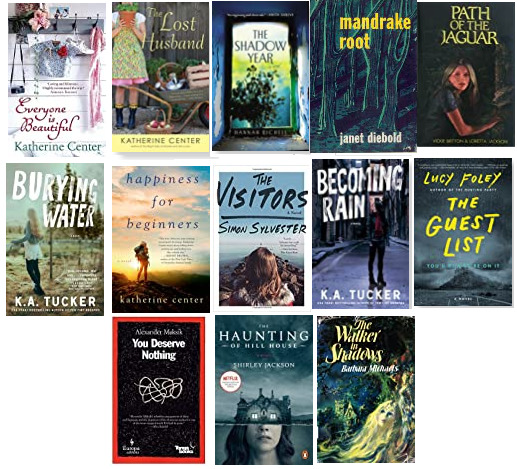
I read each of these books because...
A Glitter of Gold - Liz Johnson. 2019. It had me at "her pirate tour business," but between the shipwreck & the museum-director love interest it was like BLOOD & TREASURE ROMANCE AU LET'S GOOO.
How I heard of it: a book blog
The Last Woman in the Forest - Diane Les Becquets. 2019. Recommended by a dog lover; I'm down for a thriller about a woman who has a dream dog-inclusive job like this.
How I heard of it: a book blog
Good Omens - Terry Pratchett & Neil Gaiman. 1990. I really enjoyed the miniseries and wanted to see if the book everyone loved so much was as good (for the record: it was not. at least not if you’ve seen the miniseries first; otherwise they are probably equal).
This Is Home - Lisa Duffy. 2019. Attractive cover + I flipped it open to a random page and just liked the writing style.
How I heard of it: library
Dear Mr. Knightley - Katherine Reay. 2013. I'd had this on the back burner for a while because the MC sounded like me, and one day I got sick of not being able to find any fluffy contemporary romances with beta male heroes and decided Matthew Gray Gubler was gonna star in this one. (spoiler alert: it is a good book but that did not work)
How I heard of it: a book blog
Rubbernecker - Belinda Bauer. 2013. Criminal Minds sent me into a tailspin so I went hunting for books to cast Spencer Reid in again; the Asperger's/case-solving/difficult relationship with mother combo sounded promising. (spoiler alert: the med-student element + his social cluelessness proved too strong and I was only able to picture the kid from The Good Doctor)
How I heard of it: Googling keywords
The Swiss Affair - Emylia Hall. 2013. I got a random hankering for a student/teacher novel, and after scrutinizing the library catalog this was the only one that fit my parameters for gender, lack of adultery, and focus on romance over sex.
How I heard of it: library
Love At First Bark - Debbie Burns. 2019. I was trying to cast Wes/Jules [Dollface] in a romance novel, so I browsed through a Goodreads friend's "dog-romance" shelf and accidentally landed in a Jeid AU [Criminal Minds]. Which may or may not have been a large part of what turned me into a Jeid shipper (outside canon only).
The Mermaids Singing - Val McDermid. 1995. One final attempt to cast Reid in a novel -- a user in a Reddit post asking for this very thing suggested this, and "profiler with idiosyncracies" certainly fit.
The Wire in the Blood [and 9 subsequent novels] - Val McDermid, spanning 1997-2019. Turns out aside from being British, Reid paints onto Tony Hill EXCEPTIONALLY well, and I accidentally found myself with a little Jeid AU in the process, so obviously I read the entire series. Good crime-solving fun and all that.
Horse - Talley English. 2018. Random library pull because I connected with the writing style and it appeared to actually focus on horses.
How I heard of it: library
A Sparkle of Silver - Liz Johnson. 2018. I liked the author's other book and this was pretty much a remix of the same story, but now with a cool mansion/estate setting.
How I heard of it: looking up other books by this author
Everyone Is Beautiful - Katherine Center. 2009. Went looking for stories about strong marriages, found this on a Goodreads list of "second chance marriage" books, tripped into something like a season 9 Jim/Pam scenario. How I heard of it: Googling keywords
The Lost Husband - Katherine Center. 2013. Loved the previous book of hers I read, and the "starting life over on a goat farm" angle sounded like an ideal life to try on.
How I heard of it: looking up more from this author
The Shadow Year - Hannah Richell. 2013. Fixing up an old house?? I am THERE. Doing this in two timelines, one of which involves off-the-grid homesteading, is even better.
How I heard of it: used book sale
Mandrake Root - Janet Diebold. 1946. I needed a non-library book to bring on vacation, and after spinning in circles over what I thought would appeal to my mood in that setting, my brain randomly said "reread this one."
How I heard of it: estate sale
Path of the Jaguar - Vickie Britton & Loretta Jackson. 1989. Bought cheap for cheap thrills: a Yucatan adventure/mystery. Read now so I could get rid of it. How I heard of it: library sale
Burying Water - K.A. Tucker. 2014. The library didn't have The Simple Wild, but they DID have a book w/ an equally pretty cover that talked about a badly beaten young amnesiac (!) recovering on a horse farm (!!). What is: my top romance trope (hurt/comfort, bonus points for animals and rural setting).
How I heard of it: library
Happiness for Beginners - Katherine Center. Established quality author + summertime hiking inspiration.
How I heard of it: looking up more from this author
The Visitors - Simon Sylvester. Cool cover + setting, and a teenage protagonist usually makes adult fiction more accessible. How I heard of it: Goodreads
Becoming Rain - K.A. Tucker. 2014. I was in this companion novel solely for mentions of Alex and any people by the last name of Wells, but figured I might as well read all of it to ensure I didn't miss any. How I heard of it: looking up more from this author
The Guest List - Lucy Foley. 2020. Honestly, it just sounded like a cool thriller (and cool setting). How I heard of it: a book blog
You Deserve Nothing - Alexander Maksik. 2011. Fell down a Will/Rachel [Glee] rabbit hole and ravaged the student/teacher keyword in my library catalog again to scratch the itch.
The Haunting of Hill House - Shirley Jackson. 1959. Mom's been trying to get me to read this for years, and this time when it came up in conversation it was the right time of year, so I randomly decided to give it a shot. How I heard of it: Mom
The Walker in Shadows - Barbara Michaels. 1979. Gothic ghost story + beautiful architectural details in a historic house = yeah!
How I heard of it: Goodwill
YOUNG ADULT


People Like Us - Dane Mele. 2018. Needed an audiobook; a girls' boarding school murder mystery seemed most likely to hold my attention of the limited options. How I heard of it: Library
The Possibility of Now - Kim Culbertson. 2016. I will read anything by this author, and girl having a meltdown over a test = me. How I heard of it: looking up other books by this author
Rob&Sara.com - P.J. Petersen & Ivy Ruckman. 2004. Mostly I wanted to go back to my high school days and enjoy the format of a novel written in emails, but also, I like Ruckman. How I heard of it: used book sale
For Real - Alison Cherry. 2014. Fictional Amazing Race!! + awesome summery cover + sisters How I heard of it: library sale
The Summer After You + Me - Jennifer Salvato Doktorski. 2015. The awesome summery cover, mostly. How I heard of it: a book blog
You'd Be Mine - Erin Hahn. 2019. Gorgeous cover + the chance to vicariously follow a budding young country music star on tour for the summer.
How I heard of it: a book blog
Juniors - Kaui Hart Hemmings. 2015. The neat setting(s): a live-in guest on a wealthy estate in Hawaii. How I heard of it: Dollar store
Lion Boy's White Brother - Alden G. Stevens. 1951. Bought cheap because vintage juvenile book in a unique setting. Read now to see if I could get rid of it (NOPE).
How I heard of it: used bookstore
The O.C.: Spring Break - Aury Wallington. 2005. I keep meaning to finish this short series, and it was an easy title to count for my Mount TBR challenge.
How I heard of it: used book sale
Echo Island - Edward Karlow. 2017. Bought cheap because of the beautiful summery cover; easy read for Mount TBR so I could get rid of it. How I heard of it: library sale
Confessions of a High School Disaster - Emma Chastain. 2017. Read because of THE SUPER CUTE SUMMERY COVER (and diary format).
How I heard of it: Dollar store
Kentucky Daughter - Carol J. Scott. 1985. Working my way down the “Inappropriate Student/Teacher Relationships in YA" list because I'm in that kind of mood this year; chose this because 80s books tend to deliver the subject best*, the character reminded me of the girl in Send No Blessings, and Open Library had it. *this one was just blatant sexual harassment, though, and belonged very literally on that list
How I heard of it: Goodreads
What They Always Tell Us - Martin Wilson. 2008. I sorted the library catalog to see the oldest contemporary YA novels they still have before they get weeded, and "loner being taken under the wing of his older brother's (male) friend and falling in love with him" hit a couple of good tropes. How I heard of it: library
Bobby's Watching - Ted Pickford. 1993. Browsing around on OpenLibrary and saw they FINALLY had a copy of this book that scared me too much to finish as a kid, and which I've wanted to revisit ever since I remembered what it's called (Interlibrary Loan doesn't have it and it's Not Cheap to buy).
How I heard of it: library
Powwow Summer - Nahanni Shingoose. 2019. Always interested in modern-day Indigenous girls connecting w/ their heritage, especially if they're from my home state's tribe.
How I heard of it: a book blog
The Princesses of Iowa - M. Molly Backes. 2012. Appealing cover + heft suggesting a solid Midwestern contemporary, plus I liked the student teacher element (without a slash this time, as in "college student who is almost a teacher")
How I heard of it: library
The Sisterhood of the Traveling Pants - Ann Brashares. 2001. The Second Summer of the Sisterhood - Ann Brashares. 2003.
Long-intended reread of a college fave because I wanted see Mike Vogel in the movie, and it was summer so the stars aligned. Continued because the first book was as good as I remembered. (I would have kept going but Life distracted me for a bit and by the time I was back on track, it was no longer summer) How I heard of it: I...can't remember. Am the worst!
The Distance From Me To You - Marina Gessner a.k.a. Nina de Gramont. 2015. Hiking inspiration + an appealing-sounding romance. How I heard of it: Goodreads
Where Have All the Tigers Gone? - Lynn Hall. 1989. Will read any of her books, but specifically read this one because it seemed fairly autobiographical, and I read it NOW because it seemed durable enough to take on vacation. How I heard of it: looking up books by this author
And Both Were Young - Madeline L'Engle. 1949 (text of 1983 edition w/ material from original manuscript added back). Something reminded me of its existence and I requested it because it was the only non-animal-focused vintage teen novel I could physically get my hands on before Interlibrary Loan opened back up, and I had a craving for just that.
How I heard of it: library
The Other Side of Lost - Jessi Kirby. 2018. Established quality author + throw me ALL the thru-hike novels!
How I heard of it: Goodreads
The Vow - Jessica Martinez. 2013. Perfect scenario to run an Abed/Annie [Community] AU!
How I heard of it: I want to say...an article on a book website (not personal blog this time) back in 2013.
Moon and Me - Hadley Irwin. 1981. Was just in the mood to read an 80s teen novel and this one helped me knock off a title for the Mount TBR challenge. From an author I like, w/ bonus horse content.
How I heard of it: used book sale.
Suicide Notes From Beautiful Girls - Lynn Weingarten. 2015. I bought a blind bag at the library sale and this was one of the only contemporary YA novels in it; figured I might as well read it since I'd liked a previous book of hers.
How I heard of it: Library
History Is All You Left Me - Adam Silvera. 2016.
With the Glee rabbit hole came a Klaine spiral; this was my season 4 Tragic AU dream for them and I've been saving it for a Klainey day ever since it was published. (No I am not sorry for that horrid pun.)
How I heard of it: googling keywords
The Museum of Heartbreak - Meg Leder. 2016. The cool cover/concept of a "museum" of items reeled me in; I bought a copy a while ago 'cause the library didn't have it. Read now to see if I could get rid of it (NOPE).
How I heard of it: Goodreads
Me & Mr. J - Rachel McIntyre. 2015. Student/teacher novel that looked especially appealingly tame so I'd been saving it, but then Open Library notified me it was now only available in 1-hour increments, and I got paranoid it would disappear altogether (it's not cheap to buy or available via ILL), so I wanted it in my brain.
How I heard of it: Goodreads
Dear Evan Hansen - Val Emmich w/ Steven Levenson, Benj Pasek & Justin Paul. 2018. Fell in love with the DEH soundtrack. Play's summary sounded good -- getting to experience it in YA novel form?? Amazing.
How I heard of it: Wikipedia
Saddle a Thunderbolt - Jo Sykes. 1967
Bought a while ago because vintage horse story. Read now specifically to alleviate my pre-homesickness about moving by imagining living in an even more beautiful place than home.
How I heard of it: either a used book sale or a used bookstore...
Learning to Breathe - Janice Lynn Mather. 2018. This was mentioned on a lost-book forum and "girl with unplanned pregnancy supports herself by getting a job cleaning" piqued my interest; the setting (Bahamas) and cover made it better.
How I heard of it: Reddit
Everglades Adventure - James Ralph Johnson. 1970. Standard vintage boys' adventure-in-nature story; I like those.
How I heard of it: Goodwill
CHILDREN’S/MIDDLE GRADE

Little Women - Louisa May Alcott. 1868. Seeing the new movie and falling head over heels was what it took to FINALLY convince me to reread this childhood fave.
How I heard of it: can't remember; I was a kid
A Little Princess - Frances Hodgson Burnett. 1905. I was perusing a lot of books about classic children's books and it started to bug me that I had skipped this appealing-sounding one as a kid.
How I heard of it: can't remember; I was a kid
Little Men - Louisa May Alcott. 1871. LW sparked a fandom revival and I wanted more detail about the Marches' adult lives (esp. Jo & Bhaer), even on the fringes.
How I heard of it: library
Lady and the Tramp - Ward Greene. I saw a quote from the new movie under a gifset on Tumblr that sounded like it came from a book, and upon Googling out that one existed, I obviously could not allow the book version of a beloved childhood animal-movie fave to go unread. Especially after finding out it was super rare so reading it would be a privilege.
The Secret Garden - Frances Hodgson Burnett. 1910. Read for the same reason as A Little Princess. Can’t have one without the other, you know.
How I heard of it: was a kid; can't remember
The Mother-Daughter Book Club - Heather Vogel Fredericks. 2007. Much Ado About Anne - Heather Vogel Fredericks. 2008.
Always thought the series looked cute/reminded me of The Teashop Girls, but the fact that the first book they read is Little Women gave me the impetus to finally read this one. First book was darling so I continued to the next (but failed to continue beyond because COVID shut the library down until I was out of the mood).
How I heard of it: library
Nature Girl - Jane Kelley. 2010. I wanted walking inspiration.
How I heard of it: Goodreads
From You to Me - K.A. Holt. 2018. Mistook it for a similar-looking book I'd seen at the same time (See You On A Starry Night), but figured I'd give the 8th grade bucket list idea a shot once I had it. How I heard of it: Goodreads
Semiprecious - D. Anne Love. 2006. Cute cover + I'm starting to be a big fan of what I call "contemporary historical," for stories set mid-20th century.
How I heard of it: library
Dandy's Mountain - Thomas Fall. 1967. Vintage horse-inclusive children's book in a rural setting, I'm sold. Not to mention, love reading a summer setting in summer.
How I heard of it: used book sale
Littler Women: A Modern Retelling - Laura Schaefer. 2017. The only way to make the Little Women MORE magical is to make them younger, modern, and written by a proven quality author.
How I heard of it: a book blog
Behind The Attic Wall - Sylvia Cassedy. 315 pg/1983.
A Goodreads friend strongly recommended it as similar to but better than Mandy, and reading about it in 100 Best Books For Children sealed the deal. Read now for the Mount TBR challenge.
How I heard of it: Goodreads
The Jigsaw Jungle - Kristin Levine. 2018. I am a COMPLETE sucker for books told in non-traditional/scrapbook-esque format.
How I heard of it: Goodreads
Runt - Marion Dane Bauer. 2002. Wolf story by a quality author. Read now after owning it for a decade to see if I could get rid of it.
How I heard of it: used book sale
The King of the Cats - Rene Guillot. 1959. Bought cheap for a quick read because vintage animal story. Read now so I could get rid of it.
How I heard of it: used book sale
Just The Beginning - Betty Miles. 1976. Found cheap; always down to read a vintage book about an average girl (and I wanted to know how she'd cope with her mom being "a cleaning lady in a town full of classmates who HAVE cleaning ladies").
How I heard of it: used book sale
Harry Potter and the Sorcerer's Stone - J.K. Rowling. 1997. Been meaning to reread the series for a while now; finally got motivation to check out the illustrated edition 'cause Christmastime.
How I heard of it: originally Mom; a book blog for this edition
Echo Mountain - Lauren Wolk. 2020. Almost entirely because of the incredible clipart cover, promising me nature and a dog (and because I could get it as an e-audiobook from the library).
How I heard of it: a book blog
Knock Three Times - Cressida Cowell. 2019. I needed another audiobook for bedtime/walks and I know that David Tennant will provide.
How I heard of it: more by this author (more accurately, narrator)
NONFICTION

The Red Leather Diary: Reclaiming A Life Through The Pages Of A Lost Journal - Lily Koppel. 2008. I'm kind of obsessed with the concept of historical 5-year diaries -- and finding one like this is The Dream.
How I heard of it: Goodreads
I'd Rather Be Reading: The Delights and Dilemmas of the Reading Life - Anne Bogel. 2018. Attractive and compact book about the pleasures of being a reader? A headspace I want to be in.
How I heard of it: library
100 Best Books for Children - Anita Silvey. 2004. I'm big on looking at lists of books for children this year. These are the kind of books I know, love, and want to hear people talk about, now that I know books about these books exist.
How I heard of it: library
The Coming of Saska - Doreen Tovey Originally bought because it was cheap and featured animals, I needed a non-library book to bring on vacation, and this one is a durable ex-library copy in plastic wrap that featured a similar setting to where I was going, so: thematic.
Cats in the Belfry - Doreen Tovey. 1957. Wanted more of her books, and lo and behold the library had the first one.
How I heard of it: more by this author
Sorry Not Sorry - Naya Rivera. 2016. I'll read anything the Glee kids write, and this doubled as an easy number for the Mount TBR challenge.
How I heard of it: entertainment news websites
Living Large in Our Little House - Kerri Fivecoat-Campbell. 2016. I love tiny houses. And this one specifically mentioned living with dogs. And had color photographs.
How I heard of it: used bookstore
I'm Your Biggest Fan: Awkward Encounters and Assorted Misadventures in Celebrity Journalism. - Kate Coyne. 2016. Found cheap at a library sale -- loved the chapter headings and the fact that they were all about celebrities I knew.
Adrift - Tami Oldham Ashcraft w/ Suesea McGearheart. 1998/2018 edition. The movie was so awesome that I couldn't wait for more details about the real story in her own words.
I'll Be Gone In The Dark [NF] - Michelle McNamara. 2018. Been reading a lot of true crime write-ups on Reddit lately; decided it was time to pick up this well-received one.
How I heard of it: Goodreads
Dear Evan Hansen: Waving Through A Window - Steven Levenson. 2017. Much like The Grimmerie for Wicked, once I fell in love with the DEH soundtrack and looked up the plot summary, I wanted to read the musical's detailed background/behind the scenes story + libretto before I watched it.
How I heard of it: Wikipedia
Empty Mansions: The Mysterious Life of Huguette Clark and the Spending of a Great American Fortune - Bill Dedman & Paul Clark Newell. 2013. Love me a story about a mansion (or three). Or the reclusive and insanely wealth heiress who owns them, that works too.
How I heard of it: Goodreads
JUVENILE NONFICTION Mascots: Military Mascots from Ancient Egypt to Modern Korea - Fairfax Downey. 1954. Animal book from an author I like; read now to see if I could get rid of it (yes).
How I heard of it: secondhand bookstore
Come on, Seabiscuit - Ralph Moody. 1963. Bought because vintage kids' horse book; read now to see if I could get rid of it (and to count it towards my Mount TBR challenge 'cause it was short).
How I heard of it: secondhand bookstore
5 notes
·
View notes
Text
Yugioh S4 Ep 25: Oh Hai Mai
Heyyy we’re back. Thank for bearing with me, it’s been kind of chaos over here. Everything from a pandemic (we are very sloooowly reopening over here but I’ve been quarantined so long I can french braid my damn leg hair.) to important political protests, to getting an evacuation order because an arsonist burned down 90 acres in the heat of summer (luckily we’re all fine), to a vole that ate everything in my pandemic self-care garden so I lost my entire mind and waged war and dug so many holes and put out 17 mouse traps and set off so many critter bombs under the ground trying to kill the little bastard like it was Caddyshack (It’s still alive, ps, I lost that war). These last 3 months have been the longest decades of my life. The only month longer was the one where I’m pretty sure I had mono and it made me positive that my basement was haunted.
Man, bring back my haunted basement, Sorry if this comes through in my writing, I tried but, I can���t edit it out. You get FML-Rachel today.
Lets get back to a good, mindless distraction, lets turn on Yugioh.
BUT------->it just so happens that this episode of Yugioh has cop stuff in it, I’m just going to be blunt. We’re going into Valon’s backstory, he’s very much a victim of problems within the bizarre Yugioh legal system, and much like a Gotham supervillain, he is a symptom of the problem more than the cause.
I’m not going to ignore that, but in case you are overwhelmed about that right now, if you want to like...save this for later--I have another FMA recap coming out soon that I wrote in a simpler time before....the corona freakin ruined us all.
Last we left off, we were on the heels of Joey Wheeler, who decided to book it down the street because he wants to murder the hell out of Valon.
Youknow...Joey is one hell of a protagonist. He just does...so MANY antagonistic things.

Joey has decided that although the world is ending, and everyone left alive will be absorbed into the Great Leviathon’s big yummy tummy, which can only be prevented by three people, of which he is one of--he’s going to go sprint in completely the other direction.
We even managed to get Kaiba on board. We were ready. We were done, but then Joey had to lose his freakin mind because that’s just what Joey Wheeler does sometimes.
Normally heroes avoid the call to duty because of a severe lack of self confidence, but this is Joey, and he’s going to avoid the call to duty because of too much self confidence.
And so Joey and his Chaperone turn a corner and walk into this random orc who’s just casually living his best life and touring SF.

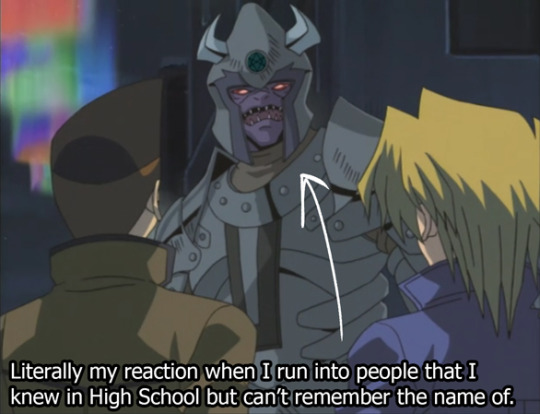
One of my worst fears walking through SF, tbh. Running into high school people. Not so much the orcs.
Yo, I wonder what the bushman was doing through all of this? So IRL, we have this guy who just...hides in a bush and jump-scares tourists. I can’t imagine what it must be like to be in a bush and then just...all these orcs show up and you’re all.
...oh no, now I’m the fool...
I just want to know if bushman made it, or if he’s in a paper card that’s just a picture of foliage.
(read more under the cut)
Anyway, Joey was already in the process of running, so they just turned around on this street of...so much parking.
Like y’all there is SO MUCH PARKING this episode. I was trying to pay attention to anything else, but like...do you see this!? It takes nearly half an hour usually to get a spot but this--this right here?
And the crazy thing is, recently my bro had to go pick up some old guy from a cruise that...got quarantined...and so bro had to go the Pier and like--this is what the city looked like. This is a pandemic, it’s just lots of parking, so I want to criticize Yugioh, and I normally would, but I can’t. I’ve seen the receipts. They called it. This is what the endtimes look like and it’s so much parking.
Also, they were too lazy to draw cars but damn, they called it.
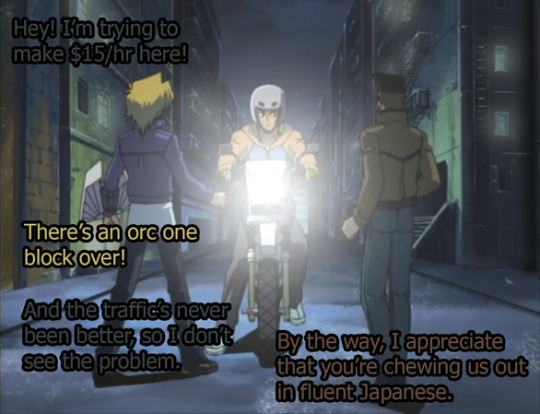
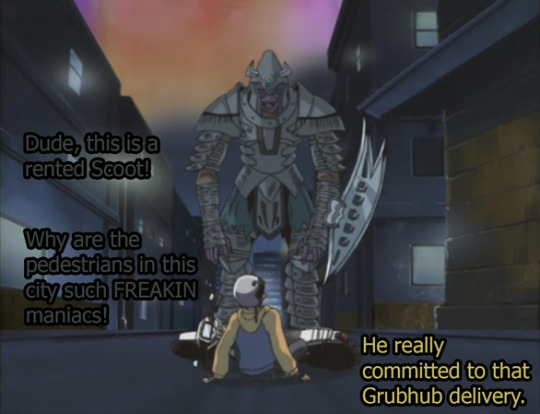
So, left with no other option, Joey decides to...be Joey, and punches a huge orc covered in armor.
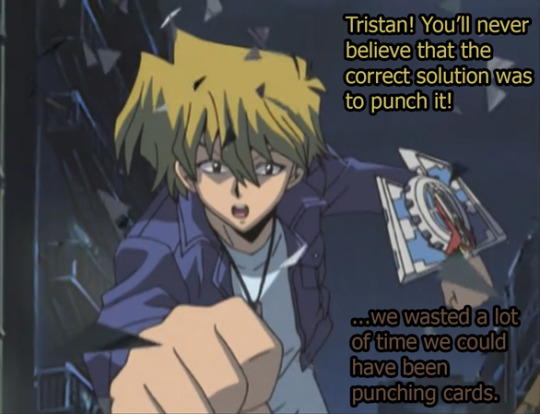
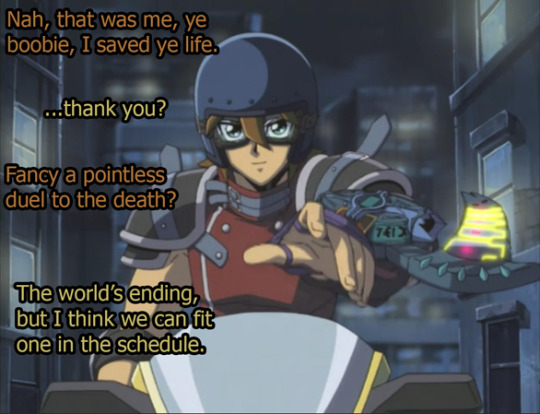
So Valon’s here, because apparently SF has just...no one left alive in it except for these few kids and that one Uber Eats driver. I imagine it’s a lot easier to find Joey if you just follow the only one screaming in Japanese in a Brooklyn accent at the top of his lungs.

And Valon decides that this one way street isn’t good enough, and that they must duel somewhere else.
I assumed it would be a tall structure, but considering Kaiba just blew up the tallest structures in the Financial District...I was like...what else is tall? And bear in mind, I’m a mess, so I was like...OMG I wish it were Macy’s!!!
Now I hear you saying that’s weird, and we shouldn’t have a very fancy Macy’s in 2020, and you’re correct. but we still have one, and the top floor is just...a massive Cheesecake factory, and I can’t think of anything more 00′s than a Yugioh duel on top of that specific Cheesecake Factory.
And I’ve never really thought before about where the best Yugioh duel would be, and it’s there. It’s at the high rise Cheesecake. Listen Yugioh, if you need an insider to choose locations for your Netflix remake of S4--call me.
So anyways, instead of doing the right thing and going to the Cheesecake Factory on top of Macy’s like any other self respecting 00′s teenager, Valon and Joey are going to drive through the most boring parts of town.
They had an opportunity to go chase eachother through any tourist attraction, Lombard street, Ghirardelli Square, the Palace of Fine Arts, China town, reuse some assets and drive through Japan town, that fountain that looks like Yoda--but no...they decided to drive through literal trash.
Just...a missed opportunity, and it should have been a Cheesecake Factory.
Also, I totally and fully acknowledge that a strange nostalgic affection for the Cheesecake Factory is a weird Millennial thing (much like our weird encyclopedic knowledge of Sailor Moon) but listen. You have your thing, too. You go do you, I’m gonna soak my sorrows in a bowl of Chinese chicken salad so wide, it’ll last me 3 days.
Anyways, Joey’s gonna steal that guy’s bike.
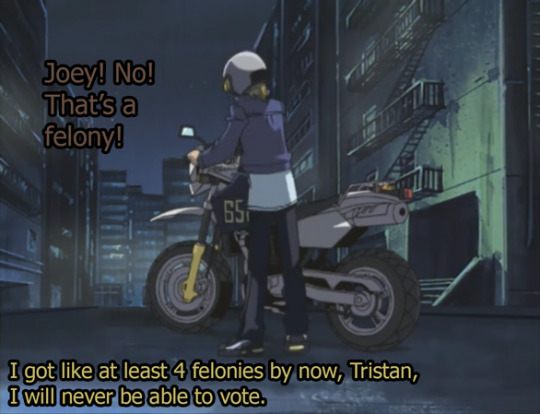
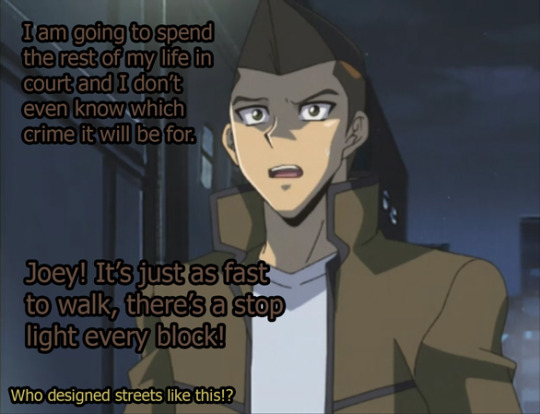
Yugioh just predicting the future in 2003. We actually have a HUGE problem right now with vehicle theft in the city to an almost comedic degree, which is partly why the parking situation has gotten so incredibly dire. It’s kind of incredible that this guy left his bike out because after about 1 day in the city you learn pretty fast that you need to be constantly checking on your street parked vehicle--I mean, that guy was just asking for it, honestly. If Joey hadn’t taken it, some other guy would have absolutely taken it, (even that orc would’ve taken it, the city has no consideration for cars.)
Sorry --one sec-- that was an earthquake just now. As I’m typing this. Just a little guy. Just a little treat for me...
...but still like...c’mon. I’m also getting this weird issue where Tumblr doesn’t save my drafts so like...this is like the 3rd time I’ve had to write this like...I just want to make a Yugioh post for my tiny funtime tv blog, Universe. Don’t @ me right now, Universe.

SO MUCH FREAKIN PARKING.

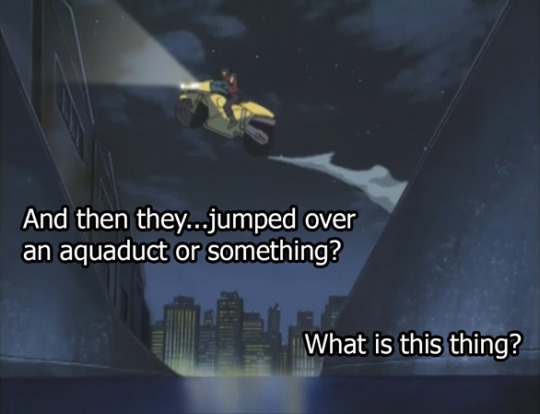
...is it the space between two piers? What is this? We don’t have rivers in SF, it is a peninsula covered in very steep hills. Like very VERY steep hills. All water just rolls into the ocean and there’s a couple of lake thingies but...no rivers that I know of (And like maybe this is a thing, and I just haven’t seen it? Learn something new every day.)

*loud, audible sigh* home. Where we belong. At the warehousssssssse.
Back at the RV base, Duke Devlin is still babysitting. Maybe this is to make up for the two seasons he spent trying to date a girl Rebecca’s age, that they felt like going out of their way to show that he has indeed no longer horny now. Got to hand it to them, that’s a lot of character development right there. Although at the same time, it has made Duke Devlin a very non-character.
But imagine how insanely complicated would it have been if Duke got involved in that bizarre love-square that is Yugi, Tea, and the Ghost that killed Yugi by accident.
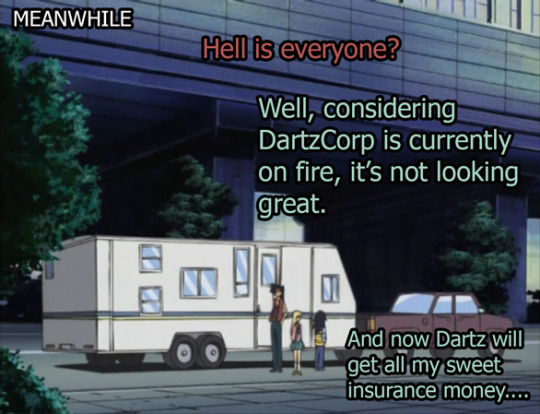
PS that’s either a freeway onramp (which is too far South from where they were, I think) or it sure does look like old Embarcadero behind them. Youknow, that lifted street from the 80′s that fell down in Loma Prieta and was never rebuilt? I just freakin love that it’s still here in 2003. This bizarre Yugioh alternate California.
Anyway, because this is alternate California, Seto set a massive fire and the entire city didn’t immediately go up in flames. Apparently they just kinda ran away from the explosion and damage before anyone noticed.
Probably because most people on Earth are dead anyway, so what more can these two actually do?

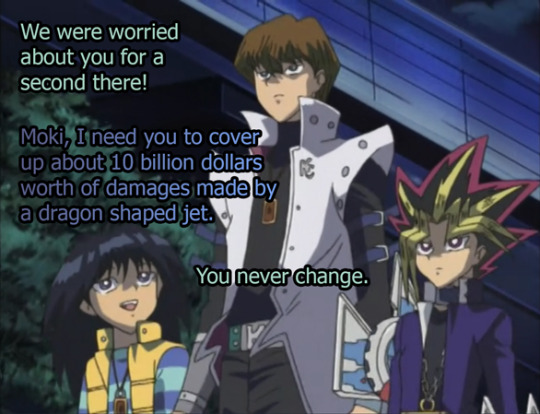
And so Yami ends up getting lectured by the wife.

And justifiably, the wife seems to have absolutely no confidence that Yami will be able to do a damn thing right.
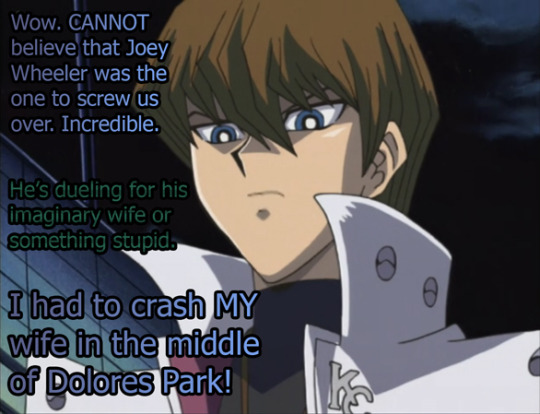
Wifes all around this episode.
Speaking of,

At this point, Arthur Hawkins senses that Yami’s nearby, so he opens the door just to freakin dump some guilt on him.
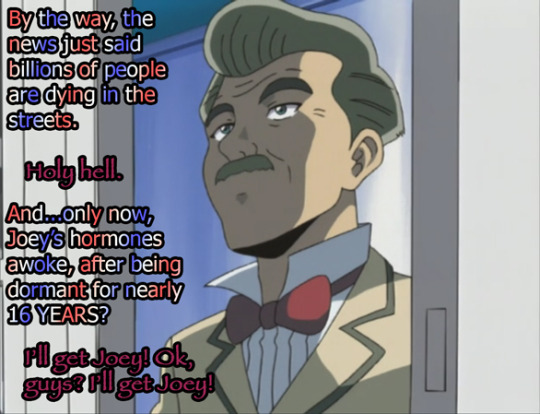

...Rebecca seems to be a character that’s mostly there to recap the lore and also to dump on Yami. I don’t mind that. Yami needs to get dunked more often, and I’m saying that in S4, where the entire season’s tagline is “how many times can we dunk on Yami?”
So lets check on Yugi, how’s that kid doing? It’s been quite a number of episodes since we last saw him.

Yep, still hanging out in the Han Solo cosplay room.
And then, because I guess everyone is just hanging out in the same 4 blocks, Mai and Tristan have a heart-to-heart.

In the show, this conversation was Mai (who is now a serial killer) saying “Oh hey, Tristan, where’s Joey?” and Tristan saying “It’s ALL YOUR FAULT he wants to kill Valon--thanks a lot, Mai! GODS!” all indignant like.
Not how you would ordinarily talk to a serial killer, just saying. No one from the Yugi crew fears this woman...at all...and she has killed over 20 people in front of them and is trying very hard to kill Joey Wheeler all the time.
Like what would it actually take for them to fear this woman? They can’t, right?
Meanwhile, Valon is trying to explain to Joey that his obsession with Mai is in fact damaging any relationship they could have had.
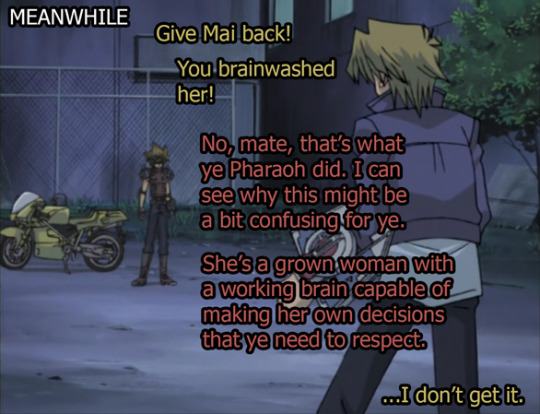
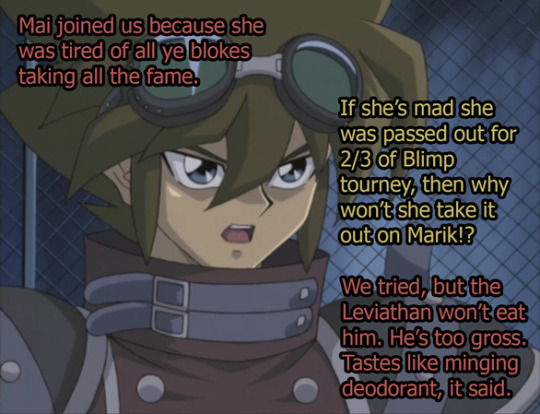

So then when you’re like OK...this is actually very valid points on Valon’s part, and Joey really does need to step back and let people make their mistakes considering Joey was barely a part of her life to begin with. But then, Valon just turns a 180 and...it becomes a catty love triangle where only one person in the triangle even feels romantic emotions.

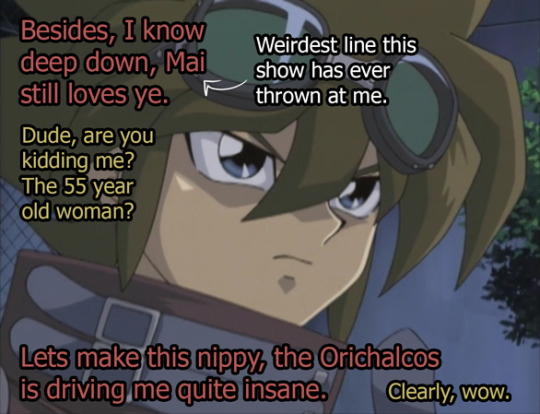

I just...so Valon is doing this fight because he thinks Mai is in love with Joey.
This whole time I was like “well maybe it’s more that Valon is trying to defend Mai’s right to make her own choices” but no...he just straight up thinks Mai is in love with Joey. And, in fighting Joey, Valon himself is ignoring Mai’s life choices
Just a whole lot of misunderstanding that would have been fixed with better ways than dueling with cards. At least that one guy in S2 who tried to marry Mai actually dueled HER instead of some random guy.
It just really feels like these boys are having a pissing contest and Mai was never let in on the deets that this was even happening.
Mai needs to hang out with older men. Set her up with Roland, this is ridiculous.

Back at the RV, which got very, very big in this shot, Seto has an odd convo with Mokuba about how they are probably not going to get Kaiba Corp back. And then no one really argued with him about that.
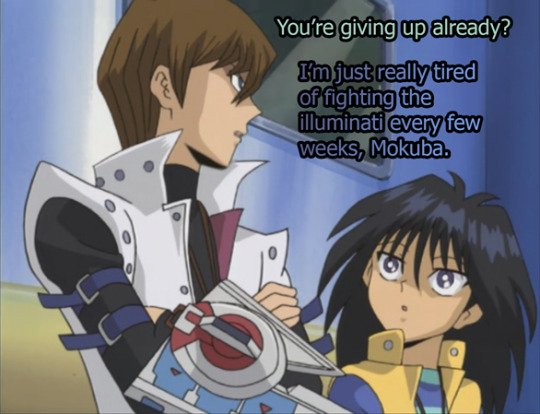
He’s taking it really well. Maybe because this isn’t even the first time or the second time or even really the third time Seto’s lost everything. Kid’s really freakin great at failure. At least this time Mokuba isn’t currently abducted, which is really good improvement for these two.
Outside the RV, Tristan has decided to...give up as well, just right here, in the middle of traffic. Then he gets Orc’d...these orcs are kind of like Slenderman, in that they kinda...show up...but then that’s all they do because the designers didn’t actually want to animate anything.
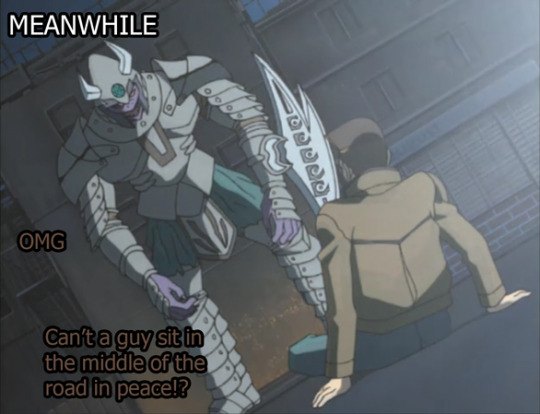
And then this happens.

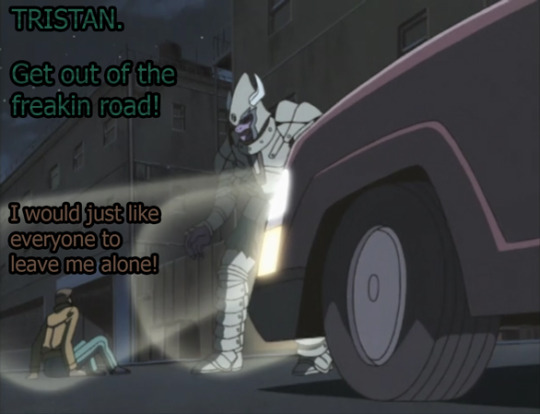
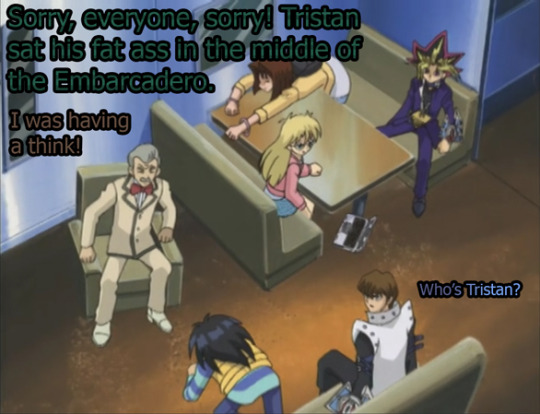
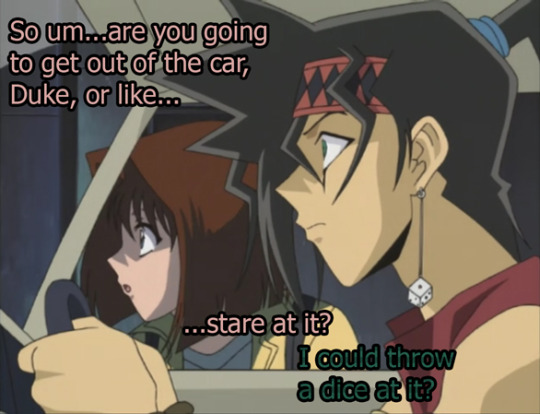
God bless this story boarder for this random series of events presented in just this way.
Also here’s yet another example where Tea just has...no fear. She’s actually only out here because she was like “that’s it, we’re getting another driver” and was going to chew out Duke Devlin. The Orc being in the middle of the road was not the reason she walked out here.
Anyways, Yami killed it because everyone here can just throw cards forever, these things are not threatening.
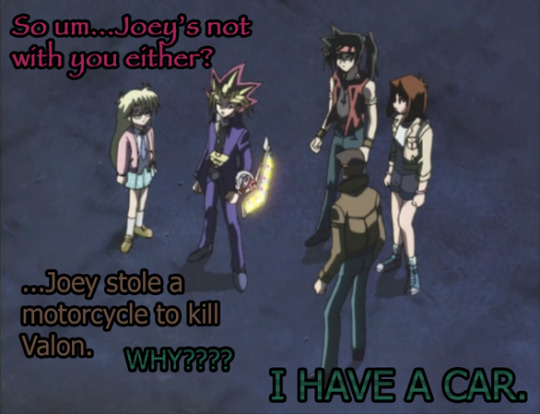
The subplot of everyone refusing to drive with Duke Devlin after he busted his car in Death Valley is still ongoing, and it’s still low key hilarious that no one will outright say “Duke, your driving is just so bad” and instead, Duke just has to sit there and watch Joey STEAL A MOTORCYCLE just so he won’t have to drive shotgun with Duke Devlin.
Rebecca, our plot-dump device, then informs us that Valon has Special Rules.
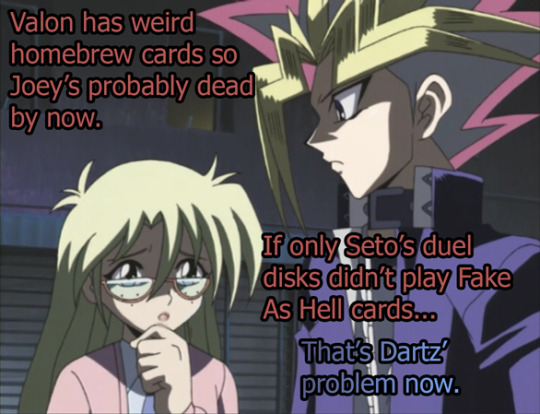
Because Valon, if you’ve forgotten, has a card that allows him to physically punch his opponent in the face.
They should have invented that card a long time ago TBH.
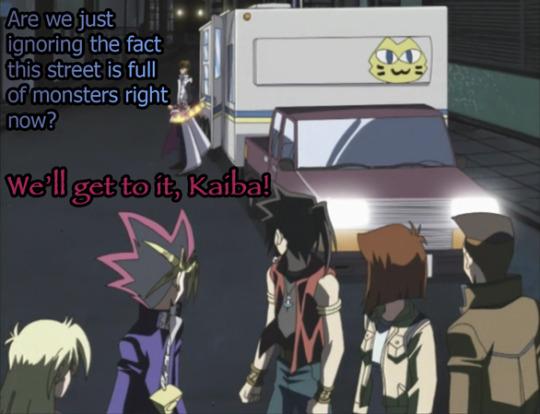
SO, lets get into Valons tragic backstory. First off, go turn on your Les Mis Soundtrack, because this is some old school cop stuff.
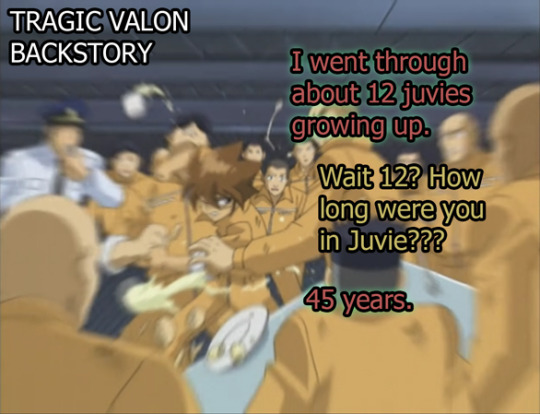
So apparently Valon, as a child just...stayed in the system forever. We don’t know why yet, but lets just assume that it’s tragic and heavy handed. If he steals a loaf of bread and ends up in 12 Juvies (which is a line from the show and not an exaggeration--12 Juvies) then I will expect him to be singing by the end of this and I will be very disappointed if he does not.

Anyways, he was such an asshole, that he caught the attention of some very illegal rich bastard who was trying to turn prisoners into...card murders. (it was Dartz.) because apparently...Dartz also funds prisons and that is...that is some deep lore.
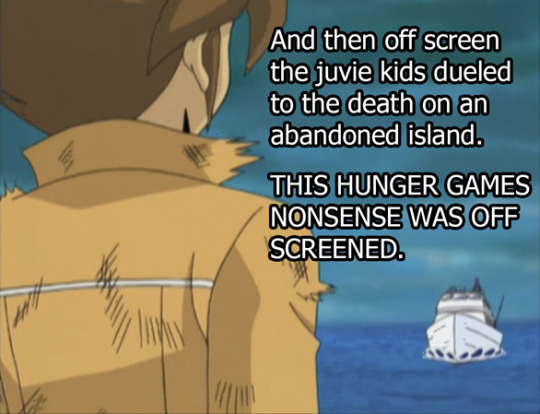
And so probably about the same time that Yugi was Dueling to the death on Pegasus’ Island, and about the same time that Marik was hanging out in the ocean next to Pegasus’ Island with a pair of binoculars, and about the same time that Noah was underneath Pegasus’ Island just watching Pegasus steal KaibaCorp, Dartz decided to make his OWN murder island--because I guess he got jealous.
Anyway, Valon won, and didn’t even need to set anyone on fire.

Those little green things there--those are all souls of prison inmates.
YUGIOH.
Millennials got DARK, OK? Freakin...we had a show for 9 year olds that went deep into the school-to-prison pipeline and didn’t even try to hide it under any layers of symbolism. Like Hunger Games at least had two people survive.
This was a show to sell PAPER CARDS.
+++++++++++THIS IS A RANT WHERE I WENT OFF ABOUT PRISON TALK IN KID’S SHOWS FEEL FREE TO SKIP++++++++++++++++++++
Now, there’s a lot of good conversation going on right now about errors in the modern justice system on not just a local scale, but on a global scale, especially regarding racial profiling and criminalization of poor, sick, and young, and we better keep pushing it. But it’s surprising when people pretend like this hasn’t been talked about for a long time. Because...we’ve been talking about it in kids and YA shows for a long time. This is not something that just popped up in 2020.
Like millennials didn’t invent this obsession with dark and gritty stories with uncomfortable themes. It’s been around for thousands of years, but back in the 90′s and 00′s, a lot of shows for YA and younger enjoyed talking about the problems with prisons and abuse of power with our justice systems--a lot. Batman, X-men, Death Note, so so many, hell, even the OC.
And like, don’t get me wrong, we still have these shows running around, but I’ve been there’s been a trend of stories (not saying names) where just...nothing bad happens. And, that’s kind of sad because...they CAN have small elements that are more progressive in them, but only brought forth with a very risk-free cotton candy fluffy coating to make the majority of the population happy.
I could go long about this, and I’m getting very cryptic. If a kid escapes to more colorful worlds where nothing bad ever happens, that’s OK--sometimes you need that, but when nothing bad ever happens surrounding certain experiences where bad things normally happen--the meaning of the story changes because it isn’t a real experience anymore.
Like I don’t want to tangent too much, and I just had to delete a lot of examples, but I know a lot of people want to write stories about misrepresented minorities and about real deal serious situations and are just so afraid of misrepresentation that they go in completely the wrong direction by not putting in anything uncomfortable at all. I think it’s important to look at the work and ask yourself is this about the minority the work should be about--or is this work about patting the majority of the population on the back and saying neat, we’ve achieved utopia without having to even do anything?
...anyway, obvi I’m ranting, but I feel like we’re taking a step backwards when it comes to the importance of kids programming and that we do need to talk to kids about prison again. This is a show about paper cards, and they don’t do a great job at talking about...the reality of prison, this was exaggerated with genre stereotypes, but at least they didn’t cover it with rainbows and unicorns, because this isn’t about how great Joey and the “normal” people are at saving Valon, this is about how society screwed Valon beyond repair, and I am 99% certain we will see this guy’s soul stuffed in a brick above Dartz’ snake fireplace.
Like, yeah he duels to the death on an island, but that’s imagery that is very close to real life prison issues. We don’t talk to kids a lot about how a lot of inmates get enlisted into the military during war times (and quite literally...duel to their death...on islands). We don’t talk about how we use inmates to betray eachother for a chance at maybe getting amnesty. We don’t talk about how a lot of the victims of this system are essentially children, and have been caught in a system of endless prison for what will probably be the rest of their lives. We don’t talk about how we’re systematically turning kids into criminals so much in kid’s shows of late...and Freakin Yugioh just did in a filler season.
....................I think our standard for modern kids programming to talk about serious issues is way too low if Yugioh just threw this out there in a filler season, is all I’m saying.
++++++++++++++++++END OF PRISON RANT++++++++++++++++++++++
So, Valon is free but...is he?

Not really, he’s just gone from one jailer to another, but at least this time he gets his own room. Don’t blame him for latching onto Dartz’ dream to end the world, because the world for him has been one behind bars. He doesn’t know it. Never been there.
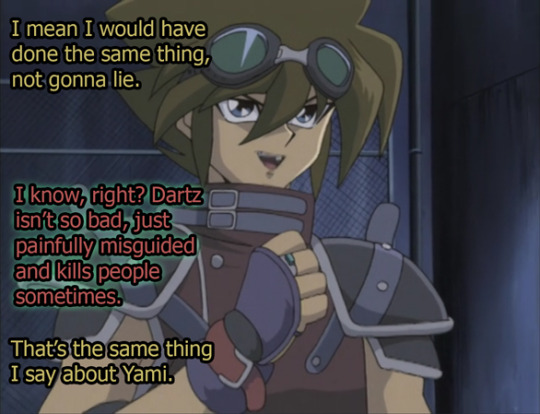
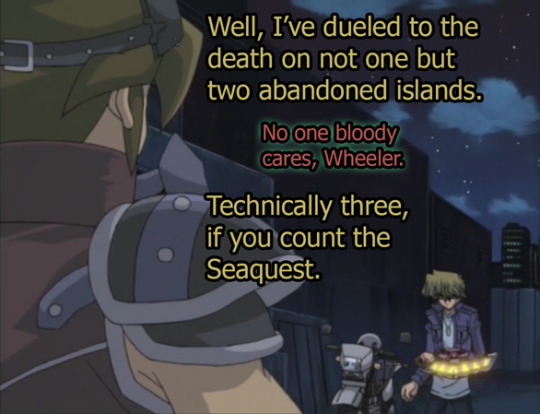
It’s just interesting juxtaposed to Joey because Joey had some sort of Season Zero history with a gang and I haven’t watched that episode yet.
So that’s it for now, again, I’m very slooow lately. I slept for 3 hours today...and I don’t know why. But hey--we all got through three (four???) months of this...we just gotta go...one month at a time.
That and I accidentally did my taxes early so there’s that. See? Good things still happen.
Also, because I only slightly referenced the most incredible movie ever made on San Fransisco soil, I’ll just leave this here. The true hallmark of our city.
youtube
Anyway you know the drill, here’s the link
#Yugioh#ygo#recap#photo recap#tw cop#tw police#tw coronavirus#joey wheeler#valon#mai valentine#tristan taylor#seto kaiba#mokuba kaiba#Yami#rebecca hawkins#arthur hawkins#duke devlin#just everyone is here#s4#ep 25#tw politics
20 notes
·
View notes
Text
April 25, 2021
My weekly roundup of topics of interest. Topics include urban heat islands, transportation safety, lighting, and cooking.
Urban Heat Island
In the last few weeks, I added some sections on light and noise pollution. Continuing on with some additional, primarily city-scale pollution topics, this week was the urban heat island effect.
The UHI is a phenomenon whereby cities are warmed up, either due to the waste heat of energy usage; pavement, roofs, and other infrastructure absorbing daytime heat; a reduction of surface area and thus heat convention (trees and other vegetation have a lot of surface area and thus are good at radiating heat); or other factors. Unlike global warming, which as the name applies affects the whole planet, UHI is mainly a localized effect and is distinct.
About 166 thousand people die every year from heatwaves. I’m not sure how many of these deaths should be attributed to UHI. The only two estimates I know about are that the UHI causes 0.42% excess deaths in Ho Chi Minh City (formerly Saigon), and that the UHI was responsible for 52% of the deaths in the West Midlands, UK during the August 2003 heat wave. That’s a pretty wide range and only two data points. If every single death from heatwaves can be attributed to UHI and we take the statistical value of a life at $10 million, then the scale of UHI gets into the trillions of dollars. In reality it’s probably an order of magnitude less than that, which would place UHI on roughly the same level of damage as ozone depletion.
Another way to get a handle on the cost is air conditioning. The UHI was estimated to cost 14 large cities 0.068% of their GDP in operating and repairing AC units alone. That’s about $60 billion per year if extrapolated worldwide, but that’s almost certainly an overestimate because the UHI is worse in larger cities.
By my crude attempt to determine the order of magnitude damages, I’d say that UHI certainly ranks below noise pollution, probably below light pollution, and again maybe on par with ozone depletion in terms of seriousness.
Above I noted three main causes of UHI, and again I am frustrated by the seeming lack of results that decomposes the magnitude of them. The same was true with noise and light pollution. This is the opposite of global warming, air pollution (to an extent), and ozone depletion, for instance, where we know in great detail what the sources of emissions are and the relative magnitude of various sources. But the lack of knowledge here could be partly the result of the fact that UHI is a very localized phenomenon, and so global averages wouldn’t be terribly meaningful.
For those wondering, the UHI is estimated to contribute about 2-4% of all extra heat associated with global warming, with the rest coming from CO2 emissions and black carbon (79% and 18% respectively). This may seem low, but keep in mind that urbanized land is only about 1-3% of all the Earth’s surface area. It seems bigger because that is where most human experience takes place. And no, UHI does not explain most of global warming measurements.
As far as what we ought to do about it, I feel hampered by the fact that I don’t have a good decomposition of causes of UHI, but white (reflective) roofs and vegetation planting in cities both show benefit-cost ratios better than 1.
Transportation Safety
How should we thinking about transportation safety, which is the probability of injury or death from various modes? This paper is pretty good. It gives the death rate for various modes by number of journeys, by hours of travel, and by kilometers of travel.
Unfortunately, it assess figures on the vehicle level (e.g. deaths per vehicle-km), and I think that on an individual level would be much more meaningful. So I estimated typical occupancy rates of various vehicles and converted them into this (not yet well formatted) chart.
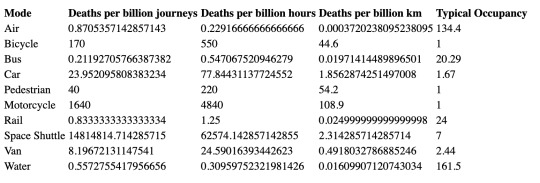
(Here I am assuming that “water” means ferries.)
The numbers are all over the board, but one thing that jumps out at me is how much more dangerous active transportation (cycling and walking) is than driving on all three metrics. By comparison, air travel, rail, ferries, and buses are much safer, which I think we generally know. Going into space is risky.
The risks of cycling are generally confirmed from other sources (like this one). Active transportation enthusiasts will often fire back that cycling is dangerous because of car usage, since it is collisions with automobiles that drives much of the risk. That may be, but I would be curious to know some more detailed safety figures. How does a separated cycle track, for instance, compare with a bike lane for safety? I’ve seen a lot of figures on this but nothing that I would regard as super reliable.
Since driving is the most common mode of travel, I also want to delve a little bit into auto safety.
Overall, I want to make a good case for compact cities, and the last few weeks have not been good for that. Noise pollution, light, pollution, and the UHI are all issues where the absolute level of impact will go down with compact cities, but the amount of exposure that people receive will go up. Insofar as we regard human health impacts as the main issue, this is an argument for less dense cities, though it would be countered by considering ecological impacts as well. As far as transportation safety is concerned, unless there are some much safer models of active transportation (I didn’t look at powered micromobility, for instance, but those numbers don’t seem to be very good either), it’s probably best to go for mass transit, which is best at more moderate densities but higher densities than generally prevail in the US.
Lighting
Lighting efficacy is a subject I looked at a while ago and am coming back to know. United 4 Efficiency is one of many sources that does a general comparison of efficiency across sources.
We are all familiar with the progress in solar PV and wind turbines of the last few years. A bit less well-known, but also important, is how LEDs have cut electricity demand for lighting, even with the rebound effect taken into account. LEDs should be regarded as one of the major bright spots (no pun intended) of progress on climate change. However, as noted a few weeks ago, LEDs could be a setback from a light pollution standpoint.
Despite the impressive progress, there are still some further advances possible, most notably with laser diodes and organic LEDs. Both technologies have already been commercialized, but are used for niche purposes so far. When they become cheaper and fully developed, both laser diodes and OLED could be more than twice as efficient (measured as lumens per watt) than LEDs on the market now.
Cooking: Gas vs. Electric
Several cities are moving to ban natural gas hookups in new construction, which would force cooking from electricity instead of gas. There are a lot of issues here, especially with cost, and there are also several differences in how dishes come out. Some chefs aren’t too happy with losing the gas option.
As for overall energy impact, if natural gas is the main source of electricity on a grid, then a switchover doesn’t seem like a good move. Why not just use natural gas directly for heat rather than converting it to electricity, then using the electricity for heat?
This is counterbalanced by the fact that electricity tends to be a more efficient energy carrier for delivering heat. A study in Korea finds that electric cooking has lower primary energy demand and lifecycle greenhouse gas emissions, and this with a national electric grid that is about 80% fossil fuels.
I’m not sure I understand or fully buy the numbers in this study, and I will have to look further to be convinced. They find that induction cooking (electricity) has an efficiency of 74.9–77.6%, while gas has an efficiency of 30.2–41.7%. That’s good for electricity, but I don’t think it is good enough to get the primary energy savings that the paper claims, unless I am missing something.
1 note
·
View note
Link
Brett Anderson and Mat Osman from influential ’90s indie outfit Suede are back with a new album and a new film to match
By Dave Calhoun, TimeOut. Posted on Friday, November 6, 2015.
It’s one of the defining images of the ’90s British music scene: Suede’s Brett Anderson swinging his mic and slapping his arse as he tore through unifying glam-rock hits like ‘Animal Nitrate’ and ‘Trash’. Along with his old school friend Mat Osman, Anderson founded Suede as a London student in the late ’80s. When Britpop exploded, the four-piece became the smarter, darker, more ambiguous face of the scene. Five albums later, they called it a day in 2003.
But Suede have been back since 2010, touring and lately recording. ‘Night Thoughts’ follows ‘Bloodsports’ as the second album of Suede 2.0. A brooding, expansive and playfully eccentric record, it nods to the experimentation and orchestral sound of their 1994 album ‘Dog Man Star’, the last to feature guitarist Bernard Butler.
Suede will be performing the album over two nights in London at the Roundhouse, also premiering a new film made to accompany the album. We met Brett and Mat, both 48, near their homes in west London.
You were up against Kanye West as Saturday night headliners at Glastonbury earlier this year. How was that?
Mat: ‘We loved it. We were only there for about three hours.’ Brett: ‘It’s a bit hit and miss for us, Glastonbury. We’ve done some crap ones. We did the main stage below REM about 15 years ago, in daylight, and it was terrible. I think we’re a much better live band now than we were even back in our heyday. We’re on a different level.’ Mat: ‘We’re also a bit less precious about not playing to our own audience. In the early days we spent a lot of time playing to people who were rabidly obsessive. So it could be strange to go to a festival and it not immediately go off.’ Brett: ‘We’ve got some resilience to that now. We were so used to adoring crowds in smaller venues, it became this little cult. I love playing live now. When we first started I used to be all about writing stuff and the studio, but bizarrely enough as I’ve got older, I actually enjoy the physicality of playing live.’ But anyone who’s seen you play live, especially in the early days, always remembers you going for it hell for leather, swinging the mic lead, slapping your arse…
Brett: ‘That wasn’t what it was about for me. It was about coming up with the magic in the studio.’ Mat: ‘I still think that’s the measure of the band for me, the albums you leave behind.’ Brett: ‘Of course it is. The live performance is transitory, isn’t it? It’s a beautiful thing. It’s life-affirming – and all that nonsense.’ Mat: ‘It’s the sex to a record’s love, you know what I mean? It’s the brief moment as opposed to a lifetime.’
‘London is this poisonous, brutal place, but there’s so much love here as well’
Last year a ‘Mastermind’ contestant picked Suede as their specialist subject. Were you watching?
Mat: ‘I was. I think he did better than all of us in the band.’ Brett: ‘What? I got them all right.’ Mat: ‘There was that hard question about who shot the photo of the two people kissing on our first album cover.’ Brett: ‘I knew that one.’ Your lyrics are full of images of the city. Does London still inspire you?
Brett: ‘I wrote a line about 25 years ago in a song called “He’s Dead”, and it’s “all the love and poison of London” and it’s one of my favourite lines. It still resonates with me. London is this poisonous, brutal place, but there’s so much love here as well. There’s so much inspiration, you can feel the power pulsing through its veins and I love that.’
Did the city feel brutal when you were fighting to get noticed as a student band in the late ’80s and early ’90s?
Brett: ‘We spent three years playing in the toilets of London, in places like the Amersham Arms and the Camden Falcon. Regularly there’d be more people on stage than in the audience. It was a very brutal way to start out. For some reason we stuck at it. Seriously, it wouldn’t have happened if we’d been less arrogant, or more sensible…’ Mat: ‘Or less talented, that’s the other possibility!’ Brett, you’ve said you always believed you were writing big Whitney Houston-style pop belters when you were writing early songs like ‘Animal Nitrate’ and ‘The Wild Ones’. Do you still feel like that?
Brett: ‘Yes. Less so with this new album. But I’ve always thought Suede’s music was quite poppy. The whole indie ghetto thing, especially in the ’90s, I thought it was limiting. Pop music is incredibly powerful, even in its most crass form. If you sit in the back of a cab and listen to Magic FM and all those sloppy, sentimental songs, they’re beautiful songs. Because they’re performed by cheesy artists, they’re considered naff. But they still have emotional resonance.’
‘We’re high art kitchen sink!
Your new album ‘Night Thoughts’ is more experimental than your last, your comeback album ‘Bloodsports’ (2013). Did you have less to prove?
Brett: ‘We definitely felt like we could do things that we wouldn’t have done with “Bloodsports”. That was very much about re-establishing the brand of the band, horrible as it sounds. There are echoes of “Dog Man Star”, which is our most loved record. But it’s a different record to “Dog Man Star”, it’s a lot harder to pin down.’ The filmmaker Roger Sargent has made a full-length film to accompany the album. How did that come about?
Brett: ‘We wanted to make one long film instead of making videos. Partly to reinforce the idea that the album was designed to be listened to as an album rather than a collection of songs. I sent Roger vague ideas about the themes of the album. Lots of it is about family stuff. Kids and parenthood.’ Do you have kids?
Brett: ‘I do.’ Are they old enough to listen to your music?
Brett: ‘Yeah, I’ve got a stepson who’s 11 and a little boy who’s three and has started to play the drums. We often play “Anarchy in the UK” together.’ So you don’t buy that line about the pram in the hallway killing creativity? Brett: ‘I just don’t believe that. I find there’s friction within the most comfortable relationship, and good writing is about documenting friction, documenting tension, for me. Or good Suede writing. And there’s always friction to find.’ Are you film fans?
Mat: ‘I think Brett’s probably the biggest film lover in the band. When we were planning the film for “Night Thoughts”, we all went to Roger with lists of films we liked.’ Brett: ‘Lots of arty stuff. Lots of Bergman. Things like that.’ Mat: ‘Lots of kitchen-sink drama.’ Brett: ‘Yeah, ’60s stuff. I think the combination of the two is where we meet. We’re high art kitchen sink!’
5 notes
·
View notes
Text
moon (1997): a Review

This year’s Nintendo Switch release of Moon: Remix RPG Adventure (listed on the eshop and other places simply as moon, all lowercase, e. e. cummings style) was a surprise to me. Although the PS1 original came out in 1997, gained a cult following and inspired mechanics and writing throughout countless games I love, I had never heard of this game until literally a couple of months ago. The new Switch release is a simple re-release with no differences from the original, except that it’s been localized in English for the first time. Now that I’ve played it, it’s clear to me that a lineage of games and their mechanics can be traced back to this one. I used to think the mechanics of Dead Rising (2006), for example, were action-based iterations on Capcom’s earlier game Gregory Horror Show (2003), which itself seems to be steeped in the mechanics of Legend of Zelda: Majora’s Mask (2000). Now it seems that the development of Majora’s Mask itself, among others, may have been influenced by moon. Toby Fox has also told the creators themselves that Undertale was heavily inspired by the game. In fact, it was that very discussion that led to the creators finally localizing the game in English this year.
moon is consistently referred to as an “anti-RPG” by creators and fans alike. This makes the most sense when considering the developers are mostly former Square developers who previously worked on games like Super Mario RPG. The game opens with a young boy playing a video game which is itself called Moon. This game-within-a-game is a traditional RPG in which the protagonist is tasked with killing as many monsters as possible to gain enough levels necessary to kill the biggest monster, a dragon accused of eating the moon. The game expertly plays with classic RPG tropes and made me laugh a few times along the way. I got a big kick out of the way none of the character portraits seem to match up with the way a character looks from the top-down perspective, a trait I’ve seen of characters in a few of the RPGs I grew up with.
The game flashes forward a few times to save files with hours of progress on them, eventually leading to the final boss of the in-game game. During the climactic final encounter, our protagonist is reminded that he’s been staying up too late playing this game and is sent to bed. Our protagonist seemingly wakes back up and, while attempting to turn the TV back off, falls into the screen and is pulled into the world in which the majority of the game is spent. As a transparent ghost in this world, the young boy walks around listening to people’s conversations. The people of this world don’t seem too thrilled about the Hero’s task of killing as many things as possible. He’s usually considered arrogant, self-centered and dangerous to the people around him, with only a few people hoping for him to complete his dark task of finding and killing the dragon.
With the help of a generous old woman who seems to think he looks like her lost grandson, our protagonist is able to take physical form as a walking, hollow pile of clothes. This is when the game’s more unique mechanics kick in. At the top-left corner of the screen, there is a clock. This clock represents which day it is in a 7-day cycle, how much time is left in the day, whether it is day or night, and most importantly, how long the player has before they need to get back to bed and rest. If the player runs out of “action points,” the game is over and must be restarted from the last save, which is the last time the player slept in a bed. When the game begins, the timer is only half a day long but by leveling up, the timer is extended and the player can relax a little more.
With this in mind, the player is tasked with carrying out tasks in a similar fashion to classic adventure games. You can talk to characters to find out their interests, their habits, and what you can do to help them. You will also be building up a collection of random items which can be given or shown to characters in order to see different responses or solve puzzles. Some characters do different things on different days of the week and figuring out why something happened at a particular time can be interesting. Sometimes you will keep an item for hours without knowing who needs it or why, but by correctly finding what it is a character wants or needs, the player can earn “Love” points which are used for leveling up.
Love points can also be earned through “captures.” The so-called Hero has been murdering defenseless creatures throughout the land. You’ll find their corpses littering the ground in almost every area of the game. The goal of captures is to find their lost souls and return them to their bodies. Their souls will have habits hinted at by descriptions of what the creatures were like while still living and each one is a small puzzle of figuring out when and where to find the soul and grab it.
As with most games of its kind, I spent about 60-80% of it finding things on my own before I finally gave in and found a guide for the rest. The game carries the same flaws as most traditional adventure games. There are puzzles with easily miss-able hints, and other puzzles that are too demanding in arbitrary ways. Of note, the fishing contest and the in-world arcade game both took up huge chunks of time and were strong points of frustration for me, but neither are necessary to see the ending and I only did them for 100% completion’s sake. If finishing this game at 100% isn’t important to you, just skip the damn things. They are bad and 100% doesn’t lead to a better ending.
My only other gripe with this game is how certain characters are depicted. There are some really, really dated racial depictions that made me a bit uncomfortable. It’s a stain on an otherwise wholesome game. I also don’t like that there are certain minigames that are required to progress that require listening for specific sound cues. It means I can’t recommend this game for Deaf or Hard-of-Hearing players who don’t want to guess their way through it.
That said, I can’t emphasize enough how great it is right now, this year, to have a game that’s largely about caring, kindness, and pacifism. There were a lot of things that made me laugh or smile throughout the game, and even a moment or two that were heartwarming enough to make me tear up. It’s a weird and wonderful adventure that I’m happy to have finished. I know I’ll likely play it again, too. I’m cheap when it comes to buying games, usually waiting for a sale before considering most, but at just under $20, I whole-heartedly recommend buying moon for the Nintendo Switch, even at full-price.
3 notes
·
View notes
Text
The list of my 20 favorite movies, vol.2 (2019-2020)
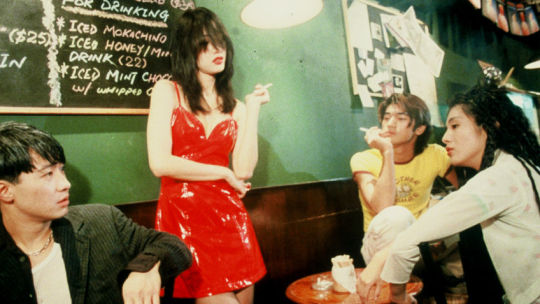
Back in 2018, I decided to start this experiment choosing my 20 favorite films, as it is at this particular moment. Used to sound a little silly to me first, yet I realized later this experiment has a merit if you do it once in a year. It’s just like a diary documenting your thoughts, ideas and sources of inspiration at some point. These things may change fast and they strongly affect person’s predilections, whether we talk about films, books or songs. It is simply fascinating to observe your personal development or changes based on the conclusions you can draw from your own favorite films. This year I was supposed to make this list 6 months ago but I just didn’t really feel like to. Now it’s time to get back to this fascinating experiment so here is its implication! 20. Spring in a Small Town (小城之春)– 1948, Fei Mu. China

Released one year before Communists’ takeover of China, Spring in a Small Town remains the most well-known film unveiling China in the period we all know very little about. The plot concerns a story of a married couple and their bitter days they live as the symbolic representation of the wreckage left by the World War. The story is delicate, psychological, poetic and beautiful. It is narrated in a very intelligent manner highlighting the exceptional talents of both Fei Mu and actors, especially Wei Wei who is still alive, aged 97 as of the end of 2019. Spring in a Small Town has been called The Greatest Chinese Movie ever made by Hong Kong Film Awards Association.
19. Masculin, Feminin – 1966, Jean-Luc Godard. France

I’ve seen quite a few films of Godard and I find most of them outstanding. However, his most politically and socially charged work Masculin, Feminin retains a special place in my films knowledge base. I’m still impressed with this combination of those monologues delivered by young Parisians and bizarre scenes from the rebellious lives of youngsters. The film features wonderful tunes turning into a great addition to the illustration of the political and social tension in France in the 1960s. Masculin, Feminin reminds that France is the most rebellious nation in the world, in terms of fighting for liberal values and equality. Moreover, the feature of Godard gives a great glimpse into several matters of gender situation and problems of France in the 1960s.
18. The Rules of Game (La Règle du Jeu) – 1939. Jean Renoir. France

One of the greatest examples of satirical films ever produced, The Rules of Game by Renoir strikes with the glorious cast, quality humour and excellent depiction of the French wealthy class decay before the devastating events of the war. An outstanding example of sophisticated director’s work and brilliant story, this film is also perfectly crafted and lensed, cinematography wise. The feature was considered controversy 80 years back upon release and almost felt into obscurity despite being the most expensive French film till that date, in order to re-gain attention and acclaim later becoming a symbol of French cinema greatness.
17. Spring, Summer, Fall, Winter… and Spring (봄 여름 가을 겨울 그리고 봄) – 2003. Kim Ki-duk. South Korea

The only Korean film I’m going to list in my 20 favorite is the most well-known feature of Kim Ki-duk I’ve been admiring or years. A very simple work based on the number of the basic Buddhist symbols and references, it is obviously made to be accessible for the Western viewers. The pace of the film is gentle and calm while the environment strikes with beauty and evocative power. I’m quite a fan of Korean movies, especially when it comes to Lee Chang-dong, though I’m yet to explore most acclaimed Korean directors and their films. Eventually, I’d keep Spring, Summer, Fall, Winter… and Spring as my favorite Korean film this year again. 16. The Straight Story – 1999. David Lynch. USA

It’s been a long time David Lynch remains my favorite director. I absolutely love Blue Velvet, Mulholland Drive, Lost Highway as well as in fact all of his works. The Straight Story however always stood out. Somehow, it feels like David Lynch wanted to show with this feature that he is capable of many different genres, styles and he’s got a strong grasp or traditionally narrated stories. The Straight Story is a bitter, wise and sublime story of an old man looking back at all his life while knowing there is nothing left to expect from the future. The life was long viewed as a vibrant matter, a treasure, an excitement. In his last travel across America, he reminisces about his life in these beautiful shots, having long Hemingway-like dialogues with the curious people he encounters. The scenery is marvelous and the music of Angelo Badalamenti is something you can never forget. No doubt, my favorite film of David Lynch.
15. Stalker (Сталкер) – 1979. Andrei Tarkovsky. USSR

Most of Tarkovsky’s films are so rich in what can be hardly seen or comprehended that I’ve been always asking myself whether I’m ready for such an art experience or not. Stalker, perhaps one of the most complicated films of him (behind Mirror, though), offers numerous layers, means, ideas and features the viewers can delve into. The film is truly intellectual and also extremely beautiful and enchanting. It is also one of the finest examples of vivacious actors’ work. Moreover, the special credit must be given to Tarkovsky’s cinematographers Rerberg and Knyazhinsky. Those iconic long takes with slow camera movement are magnificent. 14. Syndromes and a Century (แสงศตวรรษ) – 2006. Apichatpong Weerasethakul. Thailand

It is said there are some feature-length films, of which the viewers cannot get much unless they watch together with the other films of the same director, as these loosely connected works can be comprehended together. From my point of view, Apichatpong Weerasethakul and his art is the case. I could name several films of him I admire, yet I can’t say I really liked any of them when I watched them first. It takes quite some time to familiarize yourself with his work, in order to understand how you can comprehend it. The yield might be highly awarding for many of those who’s got passion and absolutely fruitless for others. Syndromes and a Century remains my favorite film of the Thai director due to it’s emotionally charged shots and scenes depicting the beauty of humanity, transformations of people and their feelings. Apichatpong Weerasethakul is playing with the subtle material eventually giving space to draw numerous interpretations of his work. It’s tantalizing and entertaining! 13. Paris, Texas – 1984. Wim Wenders. West Germany / USA

The finest combination of road movie with psychological drama resulted in a masterpiece created by the German director Wim Wenders who had shot this film in the United States. The story is very emotional and very intelligent at the same time. Also, it is one of the best works of Harry Dean Stanton who has been famous during his 60-years career as an actor of supporting roles. Being given a lead role here, he really made his character special. 12. Only Lovers Left Alive – 2013. Jim Jarmusch. USA

I’ve already written and said many things about this film as Jim Jarmusch is certainly among my beloved directors, with his enigmatic style. Only Lovers Left Alive is a film basing on a number of references and themes Jarmusch has been fascinated by for years. To understand many hidden things, it is important to see all films of him and try to think in a way he does. Unfortunately, Jarmusch doesn’t make many references quite available to those who don’t know his works well. On the other hand, even those who don’t qualify can still watch this visually striking story and enjoy the beauty of music instruments, locations, shots and aloof characters. 11. Tokyo Story (東京物語) – 1953. Yasujiro Ozu. Japan

According to many of the most acclaimed film critics and directors, Tokyo Story is the greatest Japanese film ever made and maybe of the finest masterpieces ever. The Golden Age of Japanese cinema with the works of Ozu, Mizoguchi, Naruse and other directors was truly marvelous, and Tokyo Story is widely considered to be its acme. The famous tatami shots, slow plot development, simple but very deep story, fantastic play – all these well-known Ozu’s features are present here in abundance. This is a film of an exceptional emotional degree ensuring the full immersion into it. The pace might be slow for many viewers and requires some exposure into Japanese classical cinema. Yet this experience is certainly worth acquiring, as the harmony with Japanese classic films is rewarding and memorable. Nevertheless, this is still not my favorite Ozu’s films, as of 2019/2020.
10. Apocalypse Now – 1979. Francis Coppola. USA
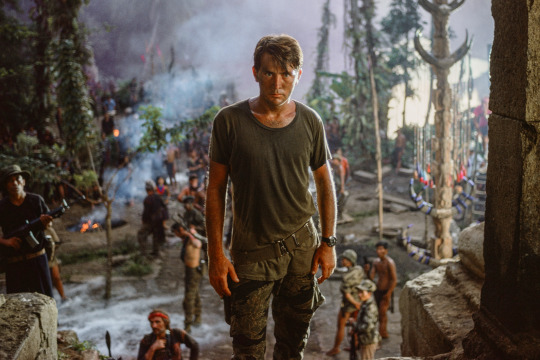
Apocalypse Now is among the greatest American films in my eyes for a personal reason. A few years back, the film had taught me to admire the cinema and provoked my keen interest in it. This epic war-related drama goes far beyond the topics of war depicting a humankind’s journey down the hell. The funnel of dehumanization as I called while writing about this film a couple of years back. Absolutely masterpiece, Apocalypse Now. 9. An Autumn Afternoon (秋刀魚の味) – 1962. Yasujiro Ozu. Japan
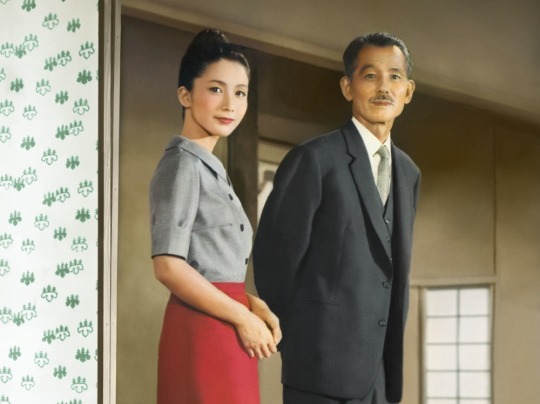
An Autumn Afternoon became a final film of Ozu. Along with his penultimate feature The End of Summer, it turned to be one of the recent treasures I discovered. The plot reminds of Late Spring, the film I named my favorite as of the end 2019. Yet the mood, key motifs and main themes are quite different. These several parallel stories within the same film depict the changing society and strong family bonds between generations. The traditional culture meets changing world showing there is always a room for wisdom, and people’s feelings don’t change in the same way as times and cultural environment do. One of the best casts Ozu ever assembled is another thing contributing to this outstanding film. Chishu Ryu, Shima Iwashita and Mariko Okada are the greatest actors of the Japanese cinema Golden Age making good replacement of Setsuko Hara who was not present here. There is so much to say about this film explaining why I love it better than Tokyo Story for example, yet I expressed it better in my older review.
8. Lost in Translation – 2003. Sofia Coppola. USA
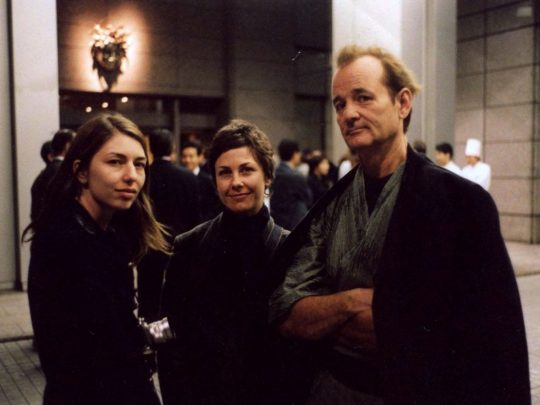
Starting with An Autumn Afternoon, my list of favorite films enters the dimension of emotions. My choice of previous movies was quite understandable in a way of common sense and proper explanations, but the rest would be nothing, but emotions. I’m quite impressed with this myself and this is just why I started considering valuable this experiment of writing a list of favorite films every year. Where would it take me? Saying Lost in Translation is my favorite American film would probably sound crazy! But here we are. How would I get it explained? Emotions. This emotional sublime charge of it is just one of a kind. A perfect style created by Sofia Coppola, a subtle story, breathtaking path and wonderful collision of fun and deep feelings… This is Lost in Translation. And there is always more and more you get and understand while watching it. This choice is romantic, but I’m getting along with that.
7. Days of Being Wild (阿飛正傳)– 1990. Wong Kar-wai. Hong Kong
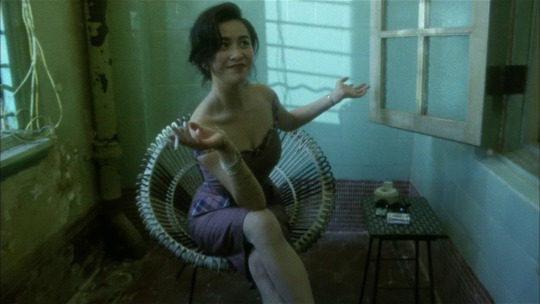
Time for the first film of Wong Kar-wai to appear in my list! Back in 2019 when I made this list last I was not a big fan of Days of Being Wild. However, I’ve seen it at least 5 times later slowly getting into this world of the wonderful romance, lovesick young people, strange lights and wonderful props and shots. The first collaboration of Wong Kar-wai with Christopher Doyle establishing this duo that would be crafting visual delights in a few other features. A wonderful cast with Leslie Cheung, Karina Lau, Maggie Cheung and Andy Lau in addition to wonderful music… It is slowly getting me, more and more. Yet again, this choice is nothing but my sense of romance in the cinema.
6. The Scent of Green Papaya (Mùi đu đủ xanh) - 1993. Tran Anh Hung. Vietnam / France

This film is shot in Vietnamese and the drama is entirely Vietnamese. However, the director Tran Anh Hung has been living and working in France for most of his life so the movie should be considered French. Nevertheless, I personally take it as the greatest Vietnamese feature film as it had opened Vietnam for me from a new angle. It is an extremely beautiful film the shots of which seem to be inspired by the work of Fellini’s or Tarkovsky’s cinematographers and are also enhanced with vibrant, vivid colors, the striking shine of nature around the characters and warmth of their emotions. A gorgeous story, a glimpse into the world that perhaps never existed, the supreme sophistication of The Scent of Green Papaya had become the last reasons for me to relocate to Vietnam, even though I always the reality of Tran Anh Hung’s film only exists on the screen. Inspiring and breathtaking, a lovely and adorable film!
5. The Assassin (刺客聶隱娘) – 2015. Hou Hsiao-Hsien. Taiwan

One of the prominent directors of the Taiwanese New Wave Hou Hsiao-hsien is a living god of art-house cinema. He had created multiple beautiful slowly paced features of which I’ve seen about 10. Relatively unknown in Asia, he has been highly respected in Europe, especially in the eyes of orientalists. His last film The Assassin has received many accolades such as an Award to the Best Director received by Hou Cannes. The Assassin is an acme of the visual beauty and technical sophistication of cinematography. This film would be very boring for those viewers who are used to the narrative features. Here the plot doesn’t really matter, as the film was made to immerse the viewers into the mood, visual beauty, atmosphere. It comes as a wuxia film, yet many critics call it a deconstruction of wuxia. The protagonist portrayed by Shu Qi gives a detached effect of both character herself and also the whole world around from the traditional way of storytelling. It really takes time to look into this film properly, I didn’t understand if I entirely liked it or not when I watch The Assassin first. I’ve started getting from the 3rd or maybe 4th time. And this is how this film is. My opinion about this film has changed a lot since the moment I wrote my first comments on it. A delight for those who admire visual delicacies, the film of Hou Hsiao-Hsien, in my eyes would probably always remain a standard of beauty I’ve seen on the screen.
4. Yi Yi (一 一) – 2000. Edward Yang. Taiwan

Getting back to the films I select as the ones standing upon the pillars of smart and intelligent stories, I’d call Yi Yi my favorite Taiwanese film ever. The last and the best feature of Edward Yang has three perspectives in its story shifting from the glimpse into one generation of the family into another. This is a story of very simple people’s relations, feelings and emotions showing how the life goes around in a circle. It is almost impossible to find any weak points of this marvelously crafted story of three generations showing so many feelings and problems related to love, middle-age crisis, development of the individuality, childhood, teenagers’ discoveries, the fate of old people. The whole life is here, in Yi Yi. The film makes the viewers ruminate and look into their own lives from a different angle. The story is being told by a wise man who has got good eye observing littlest things in everyday’s life that really matter and make a difference. With little or without action at all, the slow pace of Yi Yi brings genuine emotions to those who watch it. Like I wrote in my review on Yi Yi, it was one of the strongest impressions I have ever had watching a film. 3. In the Mood for Love (花樣年華) – 1999. Wong Kar-wai. Hong Kong
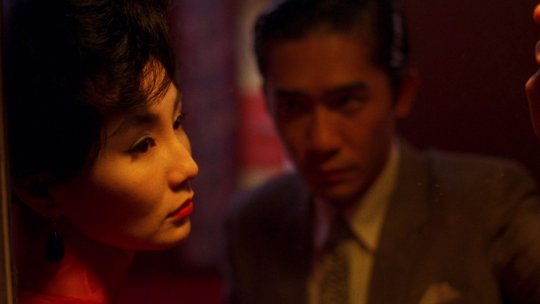
It’s been already told too much about this film in my reviews of Wong Kar-wai’s films I’ve written for my blog, and I want to stay away from iterations. I’d just say that one of the fascinating recent developments about In the Mood of Love I made is connected with the fact that one of the most important things for the director was to show the life of intelligent Shanghainese people in the 1960-s who were forced to immigrate and settle down in Hong Kong. This is the whole new dimension of the film which might be not obvious for the Western viewers, and it is fascinating. Other than that… I just cannot resist these shots in slow motion where Maggie Cheung takes me to the Universe of this story and visual style with her delicate and tantalizing sashay while the famous Yumeji’s music theme is playing. This is a supreme beauty! 02. Late Spring (晩春) – 1949. Yasujiro Ozu. Japan

Narration wise, Late Spring remains my favorite without any doubts. The best role of Setsuko Hara, the fantastic emotions expressed by the whole cast impress me greatly again and again. Ozu had created a very interesting and difficult personality Hara’s Noriko: every time I watch this film I find something new in Noriko. And yet every time it makes me sometimes cry, smile happily or it just simply casts shiver down my spine with its sophistication and development. Sometimes, I feel like watching Late Spring 24/7! This film is also extremely important for me due to becoming a strong introduction for me into the world of classic Japanese films that remains the best period and school of cinema making to me. The only one reason I don’t name this film my favorite once again as I did a year ago is my dependence on emotions making me a type to easily fall for different things based on sharp and strong romantic emotions. And my choice of #1 film is again nothing, but an emotional thing.
01. Fallen Angels (堕落天使) – 1995. Wong Kar-wai. Hong Kong

The acme of neon exuberant cinema developed by Wong Kar-wai and Christopher Doyle is a non-plot film focusing on images of Hong Kong nights and lovesick young people who are always aliens in the middle of this neon-lit night. The story doesn’t say a lot while the romance is extremely intense. This is not a movie you may like or enjoy, you can only dissolve and it and love it if you’re the type and if you watch it in the time you’re apt for such emotions. I remember the first time I watched it and I was not really impressed… Yet I realized its emotional and romantic power later. Wong Kar-wai and Doyle are crazy about neon and they take it as an encapsulation of Hong Kong’s nights. The neon is very sexy, it is a symbol of attraction and alluring sexual power. We get dozens of memorable close-ups with female protagonists shot in unnatural neon light, and their faces radiate enthralling and mesmerizing neon sexuality. Considering Hong Kong is a city full of neon, this light also represents the rush of Hong Kong’s life that is exuberant, but reluctant to consider the romantic feelings of young lovesick youngsters. The characters, these people in their 20s, dissolve in this neon world craving for love, but not being able to have even a bit of this feeling. They are trying to find their own place within this Hong Kong night, and their struggles and showed lyrically. Heroes are silhouetted in neon lights which is extremely beautiful to see on the screen. The film is a master class of Christopher Doyle giving utmost attention to the lights and inventing an enormous number of camera tricks. The shots of Doyle are visually striking and perfect. He shots different moments from extremely wide angles to emphasize different feelings of characters. Many of the shots in this film are quite iconic, especially the ones coming with these crazy angles, extreme close-ups, step-print effect and with extreme wide-angle lenses. It’s just unforgettable! Sometimes Doyle uses hand-held cameras which is punchy and quixotic. One of the most delightful and visually beautiful moments is the ending scene when an extreme close-up of Michelle Reis in the cafe, with bizarre green light directed on her. With her calm voice, she tells she has learned not to involve emotionally with the people. She talks about the weather, yet we know about her emotional wounds and woe. Meanwhile, there is a fray on the background she doesn’t even pay any attention to. The camera just stares at her, the background is blurred. And then it shows the mute guy beaten with the same type of close-up. This experience is totally about intense romance and visual delighted created by director, cinematographer and editor. And at this particular time of my life, I would name it the best development in the cinema I came across. I love Fallen Angles, no doubt a long time number one.

19 notes
·
View notes
Text
Name Ten Films That Have, For Whatever Reason, Stuck With You
@millennialfangirl tagged me, and this was harder than I thought and I might have gone over the ten. Also, tumblr is being tumblr and not cooperating with gifs, so only the first film has one. Here they are, in chronological order:
Casablanca, 1942
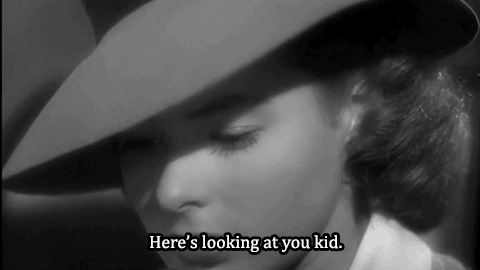
Look, Casablanca is the best film ever made. Is it my favorite? No, but it’s the best, much better than Citizen Kane, which is often heralded as the pinnacle of cinema but is about a rich old white guy who loves his sled.
Here’s looking at you, kid. Of all the Gin joints. Round up the usual suspects! I’m shocked - shocked!- to find that gambling is going on in here (Your winnings, sir.). This is the beginning of a beautiful friendship. As Time Goes By. Humphrey Bogart and Ingrid Bergman and a supporting cast to die for. Renault throwing away the bottle of Vichy water.
I could go on, but here’s why Casablanca has stuck with me: It’s one of my Dad’s favorite movies, too. When I think of Casablanca, I think of him. One Christmas (I can’t remember if I was in high school or college), the old timey theater in town played Casablanca. I got us tickets as his Christmas present. It is one of my favorite movie-going experiences (more on that below).
Star Wars, 1977
When I was little, we used to go to my maternal grandparents’ house every Tuesday, and I would watch Star Wars. I was probably waaaaay too young - there’s audio of me playing out Star Wars with my My Little Ponies and I was like, three. On my college essay, I wrote about how Return of the Jedi was my first movie (true story, I was six months old and slept through the whole thing, because apparently taking your sleeping infant to the movies is something parents did in the ‘80s).
Star Wars is where I learned about the Hero’s Journey. About princesses and rebellions and wizards and flying spaceships. I devoured the Timothy Zahn books and Young Jedi Knights series. And yes, I’m a little down on it all after Episode IX - but I still love it. It has impacted me in so many ways. I know my life would be the poorer for not having seen it.
Raiders of the Lost Ark, 1981
If Princess Leia was the first damsel I saw who get herself out of distress, Marian Ravenwood was the one who solidified the idea that women were perfectly capable of getting into and out of trouble themselves, thank you very much. Then there’s Harrison Ford in being Peak Harrison Ford as Indiana Jones - Intelligent, clever, brave-bordering-on-reckless. Who wouldn’t want to go on far-flung adventures to find hidden treasure, and maybe punch some Nazis while you’re at it?
The Goonies, 1985
Speaking of far-flung adventures, how about going on one in your hometown? Booby-traps, pirates, Italian gangsters, Sloth, hidden treasure - it’s every kid’s playtime fantasy come magically to life. I still want to go down those tunnel slides and shoot out into a hidden lagoon. They just don’t make movies like this any more - fun, family movies that don’t dumb down the action or characterization for kids, that’s a ride for both kids and parents alike. This was the first movie I showed my kids during quarantine.
The Princess Bride, 1987
Inconceivable. The Six Fingered Man. Death cannot stop truly love. Only mostly dead. Have fun storming the castle! Hello, my name is Inigo Montoya. You killed my father. Prepare to die. ROUSes.
This is a perfect movie. It is. It is lightning in a bottle and it should never, ever be remade (those were just rumors, right?). This is romance and humor and suspense and two of the best swordfights in cinematic history (fight me on this. No, really, fight me. I took fencing in college because of this movie), all wrapped up in the sweetest Happily Ever After. I love it so much.
Jurassic Park, 1993
I’ve told this story before, but here it is again. In the summer of 1993, I was 10 and my sisters were 8 and just turned 6, and we convinced our parents that we were for sure old enough to see Jurassic Park - a book my mother had read and thus knew what level of horror to expect. It did not go well. I ended up burying my head in my dad’s chest; my youngest sister was in my mom’s lap; and my middle sister, with no where left to go, ended up under the seat in front of her.
Now, it’s the movie we quote (Hold on to your butts). When my youngest had jello recently, I told him to hold it up and look scared, then texted the picture around. We all knew immediately what I meant. The DVDs are given as gifts and then immediately stolen. My youngest sister can recite the entire movie. I can’t wait to scare my sons with it.
The Shawshank Redemption, 1994
I don’t remember this movie when it came out; I remember it was this movie I hadn’t really heard of at the Oscars, where it won none. Not until I was much older did I realize what a travesty that was. I first watched this on a pep band bus trip in college - not the time or place to truly appreciate it. Months later, I rented it (remember renting movies?) and fell in love with it.
This is a beautiful movie about friendship and hope and finding light in the darkness. It’s always on TV, and I will always stop and watch at least a few minutes of it. The ending - the last half hour, really - is pure cinematic poetry, but noting beats Red’s monologue as he travels to find Andy on that Mexican beach.
That Thing You Do!, 1996
This movie is Capital-D-Delightful. Just thinking about it makes me smile. This is the movie that tipped me from Tom Hanks Fan to I Love Tom Hanks and Need Him to Be My Best Friend. He WROTE and DIRECTED this gem of a movie. The talent. The song is legitimately catchy, the characters are Wonder-ful (see what I did there?), and it’s all in Day-Glo ‘60s color. I love this movie and make no apologies.
Toy Story 2, 1999
Speaking of Tom Hanks, this is my favorite Toy Story. Look, the first is a technological marvel, but Woody is an ass throughout most of the film. The fourth is it’s own thing, and the third is really, really good and I ugly sob at the end, but it’s also got a lot going on there. But the second - oh the second is beautiful in its simplicity. In addition to all of Andy’s toys, we get Jesse and Bullseye and even Stinky Pete. It’s an ode to friendship and love and the realization that life, for toys and people, eventually ends, and we have to appreciate every moment we have now. It is my favorite Toy Story.
Finding Nemo, 2003
I don’t know if it’s my favorite Pixar film, though. It depends on the day, but most of the time that distinction goes to Finding Nemo. I first saw it when I was twenty, a decade before my first kid was born, but it has greatly influenced how I parent. The conversation between Dory and Marlin in the whale, the idea that keeping anything from happening to your kid cuts both ways, the leap of faith, the mantra of “just keep swimming,” the notion that your kids don’t just want, but need to have independence - it’s all there, in Pixar’s stunning ocean animation. I get choked up just thinking about it. “Now go have an adventure!”
Honorable Mentions:
Forrest Gump, 1994
I loved this movie. I love Tom Hanks in this movie. I would watch it in snippets during college, while I ate dinner or lunch or just needed a quick study break. But it’s been years since I last saw it, and I wonder if it still holds up. It’s a Boomer movie made when the Boomers were - basically, just a little older than we old Millennials are now. It’s American history in the last half of the twentieth century, but the big events - Vietnam, Civil Rights, even AIDS - are filtered through the lens of a straight white man who kinda wanders into history but doesn’t really get why the moments are historic. I feel like it’s a film I appreciated at a certain time, but wouldn’t love as much now.
Avengers: Endgame, 2019
There just hasn’t been enough time for this movie to make the list. Ask about it again in ten years. Although, to be honest, I haven’t seen the whole thing since I saw it in theaters, and I fear it won’t live up. It was the best movie-going experience I’ve ever had. The crowd was so into it, and the last battle had everyone, me included, screaming at the screen. Part of what makes Endgame so special to me is that, among the three big franchises that ended last year (Avengers, Star Wars, Game of Thrones), this one actually stuck the landing. And yes, I could argue that Steve Rogers’ end doesn’t actual make any sense and deprives Peggy Carter of her agency - but in the emotional moment of the film, it worked. That portal scene is the culmination of twenty-plus films, and I still can’t believe it works as well as it does.
Thanks again for this! I second tagging @lerayon for this. I feel like I’m kinda cold-calling mutuals from our Arrow days, so no pressure. But I’d love to hear what @machawicket @dust2dust34 @dettiot @theshipsfirstmate have on their lists.
5 notes
·
View notes
Note
Do you by any chance know what people consider the definitive year between “old Barbie” and “new Barbie”? I hear so many people talking about it & tbh had no idea they made anything after “Princess and The Pauper” up until the Barbie Vlogs became a thing so I’m kinda out of the loop in the Barbie fandom 😂 I’ve since seen “Barbie’s Christmas Carol” and Barbie’s Dolphin Magic in terms of movies but idk which of those is “old Barbie” or “new Barbie” or just how many other movies I’ve missed 🙈
I do know! There are currently 35* Barbie movies. Here are the basics:
“Old Barbie” is anything between 2001-2009, or Nutcracker to Three Musketeers. That’s all of these movies:
Barbie in the Nutcracker (2001)
Barbie as Rapunzel (2002)
Barbie of Swan Lake (2003)
Barbie as The Princess and the Pauper (2004)
Barbie Fairytopia (2005)
Barbie and the Magic of Pegasus (2005)
Barbie Fairytopia: Mermaidia (2006)
The Barbie Diaries (2006)
Barbie in The 12 Dancing Princesses (2006)
Barbie Fairytopia: Magic of the Rainbow (2007)
Barbie as The Island Princess (2007)
Barbie: Mariposa and her Butterfly Fairy Friends (2008)
Barbie & The Diamond Castle (2008)
Barbie in A Christmas Carol (2008)
Barbie Presents Thumbelina (2009)
Barbie and The Three Musketeers (2009)
“New Barbie” is anything after 2010, so Mermaid Tale to the present. That’s all of these movies:
Barbie in A Mermaid Tale (2010)
Barbie: A Fashion Fairytale (2010)
Barbie: A Fairy Secret (2011)
Barbie: Princess Charm School (2011)
Barbie: A Perfect Christmas (2011)
Barbie in A Mermaid Tale 2 (2012)
Barbie: The Princess and the Popstar (2012)
Barbie in The Pink Shoes (2013)
Barbie: Mariposa & the Fairy Princess (2013)
Barbie & Her Sisters in A Pony Tale (2013)
Barbie: The Pearl Princess (2014)
Barbie and The Secret Door (2014)
Barbie in Princess Power (2015)
Barbie in Rock ‘N Royals (2015)
Barbie & Her Sisters in The Great Puppy Adventure (2015)
Barbie: Spy Squad (2016)
Barbie: Star Light Adventure (2016)
Barbie & Her Sisters in a Puppy Chase (2016)
Barbie: Video Game Hero (2017)
* Barbie: Dolphin Magic is considered the 36th Barbie movie by Mattel (I believe), but since it was first reported as a 1-hour special and not a movie, that’s how I still think of it.
There is a new Barbie movie coming out this year called Barbie: Princess Adventure. I’m not sure of the release date yet (I’m pretty sure it will be fall, since the spring season has almost passed with no word about it).
These are the most basic distinctions. I have a few more that I use, but I’m not sure if other ppl use them (or if they do, I think it might only be because I do, I’m not sure). It’s based on My Little Pony terminology but again, has more to do with animation only rather than dolls, since the dolls haven’t really changed that much. I just like to categorize things.
G1: Nutcracker to Three Musketeers (synonymous with “Old Barbie”)
G2: Mermaid Tale to Rock N Royals
G3: Great Puppy Adventure to Video Game Hero
G3.5: The vlogs, since they started in G3 style and transitioned to G4
G4: Dolphin Magic, Dreamhouse Adventures/Go Team Roberts, Princess Adventure
I’m pretty sure most ppl only use “old”/“new” Barbie, tho. The distinction is pretty meaningless to me since I didn’t grow up with Barbie movies and have no nostalgia about them, so I don’t think the “old” movies are inherently “better” in any way. (This was, and to a minor degree still is a huge, stupid argument in the fandom. It’s mostly died down, but every so often someone tries to stir it up again. It’s very annoying.) I also keep putting “old” and “new” in quotes, bc the “split” came 10 years ago, so many of the movies can’t really be considered “new” anymore. (Sorry if this sounds like I’m annoyed at you for asking, bc I’m not! It’s just background annoyance thinking about the argument I’ve seen so many times over the past 7 years I’ve been in the fandom.)
Outside of all of that, there are a few extraneous Barbie things you may see mentioned around:
Barbie and the Rockers, which was a pair of 22-minute episodes later combined into one special back in the 80s. This is only really talked about nostalgically, since ppl don’t really consider it a “true” Barbie movie. It can be seen on YouTube if you wish.
Kelly Dream Club, a series of 3 episodes starring Kelly back in the early 00s. It can also be seen on YouTube.
Life in the Dreamhouse, which was a webseries on Barbie’s YouTube channel a few years ago. It starred Barbie and her friends as dolls, and was more of a self-parody than anything serious. It was quite beloved. (Personally, I got really annoyed with it, bc it had a weird, toxic fandom.) I believe it’s been removed from Barbie’s official channel, but it’s been reuploaded various places, and there are compilation episodes on Netflix (the episodes are in random order tho, and it’s not even all of them).
Barbie: Dreamtopia, a series of 10-minute shorts on YouTube, starring Chelsea. There are also two different Dreamtopia specials (Dreamtopia and Festival of Fun), that aren’t classified as Barbie movies technically, but they do feature Barbie in a minor/supporting role.
There are two 5-minute shorts that came with movies: A Camping We Will Go, for Perfect Christmas; and Land of Sweets, for Pink Shoes. Again, they’re on YouTube. (Thank goodness for YouTube.)
Aaand I think that’s all of the Barbie movies media. Sorry this answer got so long, but I was really excited to talk about it!
10 notes
·
View notes
Note
Oooo, how about two from each of them? Fanfic asks: J and P, film asks: 15 and 16, music asks: 20 and 26.
OMG thanks!!! :DDD
Ask games: Fanfic asks, Film asks and Music asks. (People you can still send me asks if you want, asks are fun to answer to!)
***
FANFIC ASKS:
A little background before we get to the questions: I haven’t written too many, actually only 6 quite short ones (and one of them is a bit longer than usual) about Die Ärzte (Bela/Farin FTW) and all of these I have written between the years 2009 and 2012, so I was 18-21 which means they are not that good. And there’s lots of things I wouldn’t write anymore. I also have a WIP on my computer, I started it in 2012 but stopped writing altogether only to start writing again in the end 2018, it has bit over 28k words currently and tbh I have written 90% of that when I started writing again two years ago. I still have my old ones up on LiveJournal (ask for a link), but I haven’t published anything fron this later one as I’ve just been writing down all kinds of snippets whenever I have had an inspiration. I think those are also a lot better in quality than what I wrote before, the old ones are quite cringey.
J. What is your favorite fic that you’ve written?
I guess we talk about those fics I have also finished, now. It’s actually hard to decide but I would say my favourite is either Why not even once? or The Boring Book Freak. I think the latter is actually The favourite.
The first one (was actually my second dä ff overall) is set to happen in 2003 and in that one Farin is leaving for another vacation somewhere and Bela wants to go with him, but Farin wants to travel alone and Bela is struggling with that, as well as with Farin finally leaving and having to somehow survive his time at home without Farin there. The writing itself is bit stupid and I feel that the end got bit too far but otherwise I like the idea.
The second one (came actually after the previous one) is set to happen in the early/mid 90s (my fave Bela/Farin era btw) and on that they just are at some random summer cottage. Now, fuck cottagecores and such, I wrote it because summer cottages are a thing in Finland and I wrote it when cottagecore was not even cool yet. Somehow I imagined that it would be very Farin-like to rent a cottage from the middle of nowhere, in a forest and then spend a weekend or so there with Bela. Who then is not entertained at all and is bored because Farin won’t put away his book and won’t give him any attention, so he tries everything to get Farin’s attention. I especially like the visual images this fanfic gives to me, I can see their hairs and outfits so well and those are also aesthetically very pleasing. (They look the same as in that Absolut Live interview from the 90s, I don’t control their looks with my fics usually, I just have an idea and then my brain creates how they look in that particular scene :D)
I have also written a short songfic around the lyrics of their song “Ich weiß nicht (ob es Liebe ist)” and it was fun to imagine that as Bela/Farin. That was fun to write.
This got a bit long so I put the rest under a cut:
P. What are your favorite tropes to write?
(Had to google what a trope is lol. I’m old-school and no longer know most of the terms unless they’re old terms.)
Angst - I put my own angst, sadness and angriness into my writing often. It’s when I feel like in real life I would need other people but I don’t know how to reach out or don’t just feel comfortable about opening up, I open up a file and start writing. This is also where we get to the next trope...
Hurt/Comfort - But not so that X hurts Y, but that Y feels hurt for other reasons and then X comforts them. I kinda got obsessed with this theme after being bullied at school so I was always hurt but never comforted, so I often go back to those feels and emotions with my text to look for that comfort (hug, nice words, whatever) I never got in real life.
Fluff - This is bit complicated because I like writing fluff but I also hate reading fluff I have written. Because it does not sound like me. And sometimes when I write, I feel like standing behind my own back and vomiting a little on the inside because of how cheesy and disgusting that is but still I can’t stop writing. And then I feel like a different person when I read them because I can’t believe it’s ME who wrote them. The same way when I watch movies and people kiss, I always look away. And I want to look away when I read my fanfiction. But I can’t, especially because I know I looked at that scene in my head when I wrote it.
Humour - I love humour so much and I like to include this to my writing. Normally I put the humour in my comics but some of that fits also in the regular texts too.
***
FILM ASKS:
These are super tough but also fun - I have been trying to think of what to answer to these for days.
15. A film everyone loves but you hate?
The Avengers (-12). Sorry but not sorry. Well I don’t hate it but I don’t understand why everyone says it’s the best Marvel movie ever. It’s not. It’s full of clichés and stupid forced heteroromances and whatnot and the plot was just so, so predictive I don’t understand why it’s often talked about as some sort of cinematic master piece. I literally was able to tell everything that was gonna happen next when I watched it for the first time. Only cool things in that movie are Loki and Iron Man, whose character I already liked as I had seen the Iron Man movie and liked it. But I hated both Thor movies (the third one is awesome tho).
I like Marvel and I have seen I guess most of the movies - before MCU all good Marvel movies to come out were The X-Men movies and Spider-Man movies, and because I saw so many terrible Marvel movies, I was avoiding the whole MCU and I got into these movies much later and still, after seeing them all, I say The Avengers is one of the worst ones. Thor and Thor 2 are pretty much even worse (and I haven’t even seen the Hulk movie because it looks terrible), mainly because I just can’t stand the fact they’re mainly just built around Thor and his love interest...
16. A film you love but everyone else hates?
Spider-Man 3 (or the whole trilogy with Tobey Maguire). I see we continue with Marvel here but seriously I don’t understand why everyone is always picking on Tobey’s version of Spider-Man? And people especially hate the third movie and how Venom was portrayed in it (I’m obsessed with Venom’s human teeth pls I want his teeth), when it’s actually the best one for me. The second one is bit boring because it was again all about whining and Mary-Jane... Anyway, the reason why I am so attached to these movies is that I saw the first Spider-Man movie from TV when I was a teenager and in junior high myself, and I was bullied and a bit of a nerd so I could relate to Peter Parker a lot, and it gave me just so much strength to see him become Spider-Man and to stand up against the bullies and other assholes.
I also saw the third movie in the movie theater and there was one scene during which I started hysterically laughing with my friend because of an expression Tobey made as he was sitting on a bed, I don’t know why but somehow I just totally lost it at that :D It still makes me laugh so much when I see it! And when the movie ended, I heard a The Killers song “Move Away” for the first time during the end credits and TK was one of my favorite bands at the time (and still is).
***
MUSIC ASKS:
20. a song that empowers you
It gotta be Dead! by My Chemical Romance:
youtube
This album was what got me through all the shit that happened when I was 15+ and especially this song always made (and still makes) me feel so good. I often listened to my old mp3 player while walking to school and back home and every time this song came by, I just felt like nothing can harm and that life FINALLY was so great! It’s so energetic and still makes me feel that living is actually super awesome.
26. a song that taught you a lesson
Hmmm. I think I will answer to this with Dusche by Farin Urlaub.
youtube
That thumbnail is terrible but... And why did I choose this song? Well, I’m all for the sound what comes to music and I’d say at least 80% of all lyrics go way over my head. I just don’t have the skills for understanding poetry and also very poetic lyrics make me go crazy. I hate not knowing and when I have to assume, guess and interpret something. I don’t want to guess but I wanna know what someone has actually thought.
Dusche was the first song that had lyrics that for the first time ever actually spoke for me. I probably saw some video with English subtitles a fan had made and it just blew me away because holy shit, people are capable of writing lyrics even I can understand??? And that way I realized I can like lyrics but only if they make absolutely no sense (aka are funny or somewhat crazy, like Dusche) or when they are written in a story form or sung from the 1st person view or to “you” or in passive - but only if I can get behind the idea there.
After Dusche, Farin’s song Porzellan followed. And one of my absolute favourites is Karten. So, Farin is one of the only few people whose lyrics I have been able to understand. I still don’t hear lyrics and don’t understand a majority of the lyrics my fave bands write, and I have understood only a couple of Bela’s lyrics and I’m not sure if I’ve understood any of Rod’s lyrics. It’s not even about the language barrier anymore really, it’s just the topics or wordings I cannot comprehend.
Thank you again for the ask! This was very interesting to ponder and answer to :)
1 note
·
View note
Note
So the oldest show I see you talk about is usually The Facts of Life but usually you don't go much further than 80s and 90s. I am very curious to know if you have favorites from the 1950s, 1960s, and 1970s (not including TFOL obviously)? And explanations why! Hopefully something to keep your brain occupied during quarantine.
Ha, I was about to point out that TFOL was technically started in 1979 haha and thank you for the question
When I got this ask, the first thing that came to mind was The Twilight Zone. I’ll save my rant about that and some other shows under the cut.
Tbh, I haven’t gotten into a lot of classics pre-1980/1979-ish. I’ve had I Love Lucy in “My Stuff” on Hulu for, like, years now, but I haven’t sat down and watched the whole thing. I definitely watched multiple episodes back when it was on Nick at Nite. If it was on Nick and Nite in the 90s or in some other form of syndication, I’ve seen at least a few episodes. Bewitched, I Dream of Jeannie, Gilligan’s Island, Andy Griffith, Mary Tyler Moore, Dick Van Dyke, etc.
A lot of older shows that I want to watch just aren’t available anywhere, or they weren’t available when I last looked. One that springs to mind immediately is Maude. It isn’t available anywhere past paying about $20 for the first season on Amazon prime which…I’m not really able to do atm. I know that features a younger Bea Arthur and touches on some controversial issues including gay rights and abortion and so many progressive causes I’d love to see. I think I’m more interested in that than the show it spun off of, All in the Family.
Other shows I’ve had difficulty finding but want to watch:
Diff’rent Strokes (at least for the backdoor pilot of TFOL lol but it’s only on Hulu with the Starz add-on, which I don’t have)
The George Burns and Gracie Allen Show
Kate & Allie (1980s but I have to complain about how it’s fucking nOWHERE AND I JUST WANNA WATCH JANE CURTIN)
Anyways, for shows that first came to mind at this ask:
The Adventures of Rocky and Bullwinkle: Since I grew up with baby boomer parents, this was right up their alley back when they were kids, particularly my mom, since she was around 7 when the show started. We owned some episodes, if not the whole thing, on DVD when I was little and I loved it. My grandmother would tell us “Fractured Fairy Tales” a la one of the segments. I excitedly saw the movie back when it came out. I truly just enjoy the show, even if its “just” meant for kids. It’s fun and sweet and I obviously love good, dumb puns.
Also, two of my favorite Rocky Horror callbacks reference it. One of the most famous and classic callbacks is the Rocky Horror Roll Call: “Janet!” “Dr. Scott!” “JANET!” “BRAD!” “Rocky!” “BULLWINKLE!!!!”
One of them isn’t as common, I’m guessing because you have to know Rocky and Bullwinkle past the name to get it. “I grow veary of this vorld! When do we return to Transylvania, HUH?” “AFTER WE CAPTURE MOOSE AND SQUIRREL!”
And a theater back in Kansas did a fringe festival production of Rocky Horror mixed with Rocky and Bullwinkle called, of course, The Rocky & Bullwinkle Picture Show. It was hilarious.
Laugh-In: Did anyone else have a bit of a TV schedule memorized for when you were sick, or was that just me? Lol back in elementary school, this would play on one channel and I’d normally watch an episode of it and then normally, like, Hamtaro after that lol I have specific memories of both of them ;alsdjk. It’s obviously best known for launching careers of many comedians, including Goldie Hawn and Lily Tomlin. And, of course, the time Nixon appeared on it to say “Sock it to me!” The 30 Rock parodies of it cracked me up.
I just found out that at least one season is on Amazon Prime which makes me very happy.
The Twilight Zone: For someone who loves sitcoms and pretty much refuses to watch any prestige TV dramas, I really fucking love TWZ. One of my weirder life/pop culture goals is to see every episode in every incarnation, the first one having the most episodes and seasons (5 seasons, over 150 episodes) starting back in 1959. It’s particularly a weird one for me because I can be a bit easily spooked—like, I can’t do true crime whatsoever, it freaks me tf out and when I read through cases of things like that I have to watch something lighthearted or else I won’t be able to sleep lol. TWZ is easier for me, though. I also grew up with a lot of this on DVD due to, again, my baby boomer parents growing up with it.
I’ve seen an episode of the 2002/2003 reboot, the remake of one of the best (and most famous) episodes, “The Eye of the Beholder”, and I watched the first two episodes of Jordan Peele’s reboot, but haven’t finished the season. Ultimately, while I enjoyed his first episode, which I found very original, and his retake on the classic "there’s a gremlin on the wing of the plane!” episode, I find that doing an hour long show is just not a smart move when it comes to TWZ. For a bit of fun trivia, TWZ was originally cancelled after its third season, but CBS brought it back to replace two half hour shows mid-season, meaning the show had to be an hour long for s4, when it was originally only half an hour. S4, last I checked, isn’t even available on Netflix and seems to only be on Hulu. It was pretty much considered a failure to everyone and when you look at lists of the best twilight zone episodes, most people either ignore s4 or will throw one in while basically saying “well, we SHOULD include at least ONE…”
TWZ really showed how much you can fit into half an hour, and a lot of the episodes feel so much longer—in a good way, of course. While back then there were less commercials so the shows could be slightly longer (25 minutes according to Wikipedia compared to 22-23 minutes nowadays), it still managed to pull you in and hold your attention and not overstay its welcome. I find that the hour long versions of the show make it harder to stay engaged and the pacing really has to slow down to fill in the space.
However, I do enjoy how each incarnation has used sci-fi/fantasy to approach fears and prejudices of the time. I know the 2002 reboot redid “The Monsters Are Due on Maple Street” which, back in the original ‘59 series, was about fear of communists and the like, and made it about fear of terrorists and Islamaphobia. Jordan Peele’s obviously tackled a lot of racism and I know the third episode, without having seen it, was about police brutality against black people. The show definitely has the potential to tackle heavy subjects in a great way, I just think its a show meant to be half an hour.
And another side rant, TWZ >>>> Black Mirror. I’ve read through the summaries of every Black Mirror episode and have seen a couple, including the perfection of “San Junipero”. Besides that episode, I really don’t like the show? TWZ managed to be original and have varying endings and had messages besides “technology bad”. It’s why I can like “San Junipero” for being so unlike the other episodes. I’ve enjoyed some of the twists I’ve read, but a lot of it just rings hollow compared to TWZ for me.
So, that’s about it for classic shows I could call favorites, though, tbh, TWZ is probably the first I’d say is a favorite of these or any pre-1980s show.
In general, since the 90s shows defined my childhood, I’ve been enjoying watching those during this pandemic for nostalgia and comfort. I’m cycling through two shows I’ve watched all of before (3rd Rock from the Sun and Cybill) as well as one I’ve possibly seen all the episodes of but only through syndication and never straight through (The Nanny). But depending on how long we’re here, maybe I’ll get a chance to watch some of these older classics on my list!
1 note
·
View note
Text
The Memetic Race to the Bottom
On Tumblr, I started seeing that there is a real way how good ideas can go bad simply because the ideas just don’t scale very well outside of the specific conversation they originated in. (The cultural appropriation conversation is one of these.) This does not invalidate the original idea - but a big danger is that a idea dumbing down too much, can make people reluctant to engage with it at all once it’s gotten beyond its original space, so that the scaling into the general public becomes part of the extinction/invalidation cycle of that idea rather than leading to the broad adoption of it. (And then once it does scale to the public, the pushback can cause a full on pendulum swing in the culture - which is where I feel like we are at with the main social meme I’ll be using as an example. The present mainstream culture is a huge *pushback* on that meme, which I’m calling Toxic Independence.) The example I’ll mainly use here, is what I’m calling Toxic Independence, mainly because “Anti-Codependency/Neediness/Enabling Culture” is just too much of a mouthful. This didn’t start off the Objectivist-adjacent space of normalized sociopathy that it became. Codependency, neediness, and enabling, after all, are all actually real things that very much need discussion. But the broader culture just did not know what to do with these concepts once they reached escape velocity into the mass consciousness. In many cases, the idea breaching into mainstream public consciousness, is actually the last stage before it completely gets discarded. This doesn’t always happen, but I feel like I’ve seen it happen with enough ideas. All it takes is for the most dumbed down version of the idea, to become the new “poster child” for that idea, and lots of people to broadly reject it. Eventually, the idea dies out. Another thing that can happen is that a meme can go extinct if the original people with the idea, end up getting deplatformed. Or if the torch just isn’t passed to the next generation. That’s how so many of the more positive Boomer social memes ended up lost by the 1980s, and ultimately, forgotten. The activist/counterculture Boomers were deplatformed and also weren’t the ones having the kids. Every hippie that moved to rural Oregon in the mid-late 70s was a voice lost, and the yuppie Boomers became the dominant cultural force in a lot of spaces. And they managed to pass *some* memes on to Gen X (Toxic Independence or Anti-Codependency/Neediness/Enabling Culture was still a big part of many of my middle class Gen X spaces in the 00s). But sometimes the meme contains the seeds of its own extinction. I feel like Toxic Independence did. Instead of a broad conversation that I hear in most of my spaces, it’s now a niche conversation in a couple of very, very specific spaces. I would have to actually seek out those conversations. And I still hear people talk about codependence - but it’s in specific addiction/recovery-specific contexts, or among much older people, and nobody seems to be trying to make it the Grand Unified Field Theory of People anymore the way that they were in the 80s. Sometimes the meme comes under broad attack by the culture itself. As left/right political polarization was picking up speed in the last decade or so, you started seeing Toxic Independence under attack by both the Left *and* the Right, and not even by the most extreme factions of each. The hetero female version came under attack via both intersectional feminism *and* traditionalism, for example. The male version became even more niche and subcultural. The Personal Development movement of the 00s was probably this meme’s final form. But even PD environments aren’t pushing this anymore to nearly the same extent, and the PD people who promoted it, are now mocked to some degree: I don’t feel like people are as universally told to cut off their ill, disabled, or unemployed family members the way they were in the 80s and 90s. I mean, there may still be this pressure in a lot of spaces, but I don’t feel like it’s as overt and aggressive outside of specific socioeconomic niches and professions. When I was around Landmark people in 2016, the conversations were fundamentally different from the ones I had with Landmark people in 2003. Now, it seems like you only get to go away once you become rich enough to throw money at the problem, or are sociopathic enough to be unaffected. Sometimes the conversation moves on because future generations change the conversation via trial and error. It’s coming out in the wash that while the first generation of people to do it en masse may have fucked it up (and then written it off as not at all working - which is what a lot of Toxic Independence was a response to), there’s been a good 50 years of R&D on the problem since. It turns out that cooperative co-living (with mutualistic, not parallel-independent or nuclear, household economies) was the meme that just wouldn’t die. The failures of white hippies weren’t because co-living doesn’t work, but probably owe more to being the first generation of middle class white people to try to figure out for the first time what everyone else has already been doing forever. Sometimes the social space shifts: geek culture is becoming a much bigger share of the middle class than before, and I feel like Toxic Independence never really caught on in geek culture the way it did in the 80s mainstream aspirational space. If anything, geek culture was the one space where a lot of hippie torches ended up passed - for example, the idea that you can have a household that doesn’t consist of one provider male and a bunch of dependents, *and* you can also have a household that doesn’t consist of two fungible co-equal earners each half-financing a significant lifestyle upgrade, and that functional households don’t have to have any one particular shape to them. Most geek spaces I’ve ever been in, have been mixed economy to some degree. Geek households seem to come in a whole variety of shapes. There seems to be a greater acceptance of people helping or even supporting unrelated adults in many geek spaces in ways that I haven’t seen outside of geek culture, which is where we get the conversation about “that guy on the couch” but it’s also why it’s a space I’ve been able to stay in since becoming a low income person with chronic pain. (We really, really need to have a conversation about the geek culture’s problem with grifters and con artists, though. And geek culture could probably *use* a little more conversation about codependency. But this is a serious place where I don’t know how to not throw out babies with the bathwater, because that same discussion is where Toxic Independence came out of. And how to have that conversation but not fuck over the very, very many disabled people in geek culture? I don’t know.) The privilege and ableism assumptions in Toxic Independence made the whole thing fall apart like a house of cards when confronted with the Great Recession and actual intersectionality discourse. Also, the pendulum swing toward online transparency and vulnerability made it so that we began to actually see more of the shape of each other’s lives - and this revealed that so much of Toxic Independence was based on smoke and mirrors. Sometimes the environment around us changes. In the 80s, it was possible to be totally self-contained the way that the books told us to be, on a much lower income than would be required now. In the 80s, you could live like this and be middle income. It’s much harder when you actually have to Now, in many spaces, you probably have to be high professional income to pull this off, at minimum, *and* it assumes you will never end up primary financial support or primary caregiver for *anyone* (unless you’re wealthy enough to not require any kind of mutualistic relationship with any co-caregivers.) (This is a way that traditionalism actually was part of the death knell, I suspect. It tries to hold onto a family shape that even predates Toxic Independence *and* it explicitly identifies Toxic Independence - under other names - as a problem.) Lots of people have had to fundamentally change the shape of their households and lives to *remain* middle class, whereas 80s psychology around being middle class was hugely about shedding as many dependencies as possible. You can only really be totally self-contained the way that the books told us to be in the 80s, if you are financially stable, if your parents are financially well set, and if you have no dependents, and if your social space allows absolutely no weaker parties. It’s clear to me that while Boomers could carry on with Toxic Independence (so long as they actually retire affluent), Toxic Independence stopped working for a lot of Gen X. Most Gen Xrs I know are having to juggle multiple dependencies. Toxic Independence just does not work for the middle class of the Sandwich Generation. Many, many ideas get thrown away because of the Memetic Race to the Bottom; the Memetic Race to the Bottom can make lots of perfectly sound issues very, very difficult to seriously engage, and often the entire framework has to be thrown away. Which means that if there was a grievance by a marginalized party that started the whole conversation, the whole discussion has been taken away from them and the milestone shifted. (This has happened with any discussion of cultural appropriation that isn’t centered specifically in ethnically/racially specific contexts, for example.) When something is in its end phases, you’ll notice that younger people are not taking that idea up. Newer experts aren’t exploring it. The original fans or adherents will still be there, though, and they’ll eventually get older. But the ideas they talk about, will stay within their group, and the memetic space they occupy will lose broad relevance. There is always life experience, educational background, professional context (was this a conversation between academics? Was it a policy conversation?), and *specificity* (such as, specific events - for example, *specific* grievances) in the original conversation, and when the ideas scale, it becomes a race to the bottom for whichever member of the general public (who was the least involved in the original conversation) has the least nuanced, broadest, most authoritarian, most prescriptive interpretation. And this is what happened to codependency, how it devolved from something that actually had a specific meaning and context within addiction psychology (and to my knowledge, still do), to a set of toxic social memes that mainly were about providing a social scaffold for 80s/90s middle class/yuppie selfishness culture - a way to weaponize what amounted to Applied Objectivism 101. I’ve found it really hard to talk about codependency for years because of this. For example, I don’t feel like I’ve met anyone younger than Gen X who identifies as codependent unless they’re actually using it in an addiction/recovery context; that is not the language that Millennials and Zoomers seem to be using. I feel like it’s mostly Boomers, Jones, and Xrs that I’ve heard use these concepts, and I’ve stopped hearing them used by Xrs so much in the past 15 years.
6 notes
·
View notes